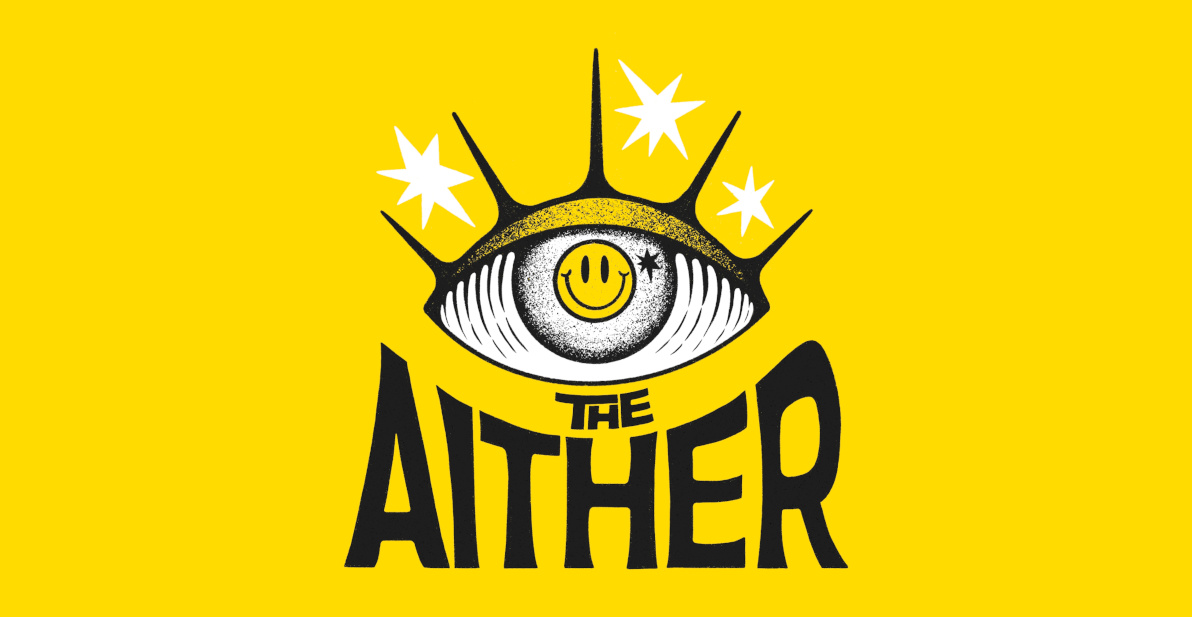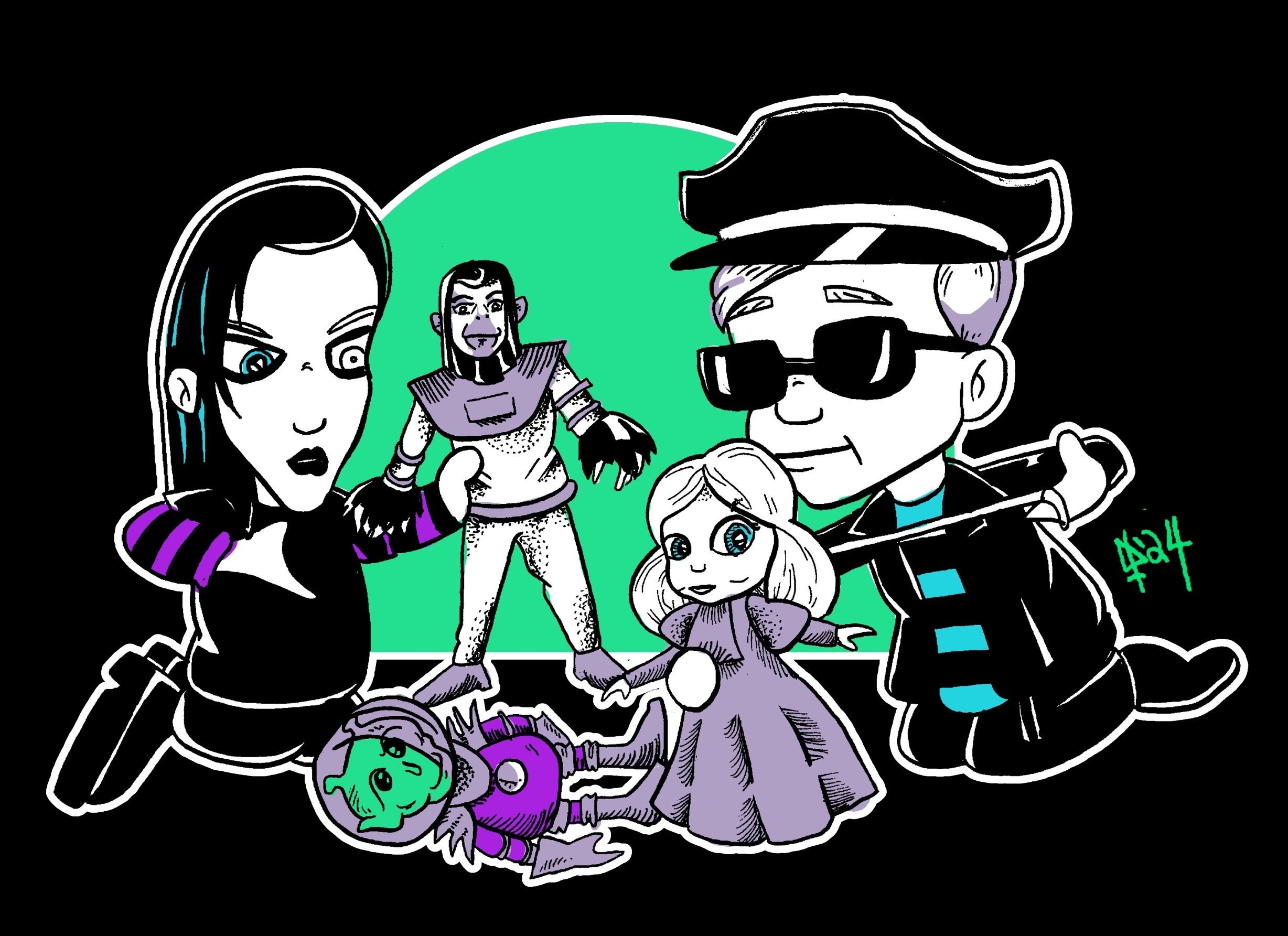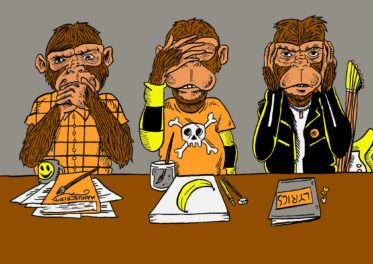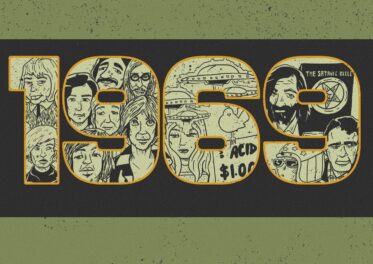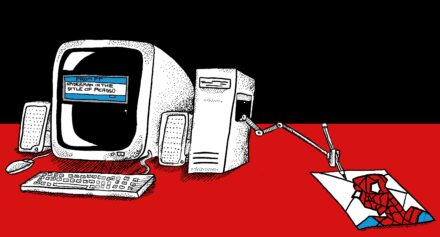Back in the 1990s Boyd Rice – musician, writer, and iconoclast – had a bit of a side hustle going as a freelance journalist. Writing articles on various aspects of underground culture, and interviewing a wide range of creatives.
One such piece was an interview Boyd conducted with legendary goth-rocker, Marilyn Manson. Published back in 1996, in issue 40 of much loved periodical ‘Seconds Magazine’ (founded by noted journalist Steven Blush). The interview covers a wide range of topics, from fame, to Manson’s recently-released-at-the-time ‘Antichrist Superstar’ LP, and the Church of Satan.
One topic these two seemingly sinister gents cover in quite a bit of depth, is toys! And not just any toys, but some truly weird and wonderful ones – From the late 1960s to the early 1990s.
Proving both to be true toy nerds and fellow admirers of the detritus of pop culture!
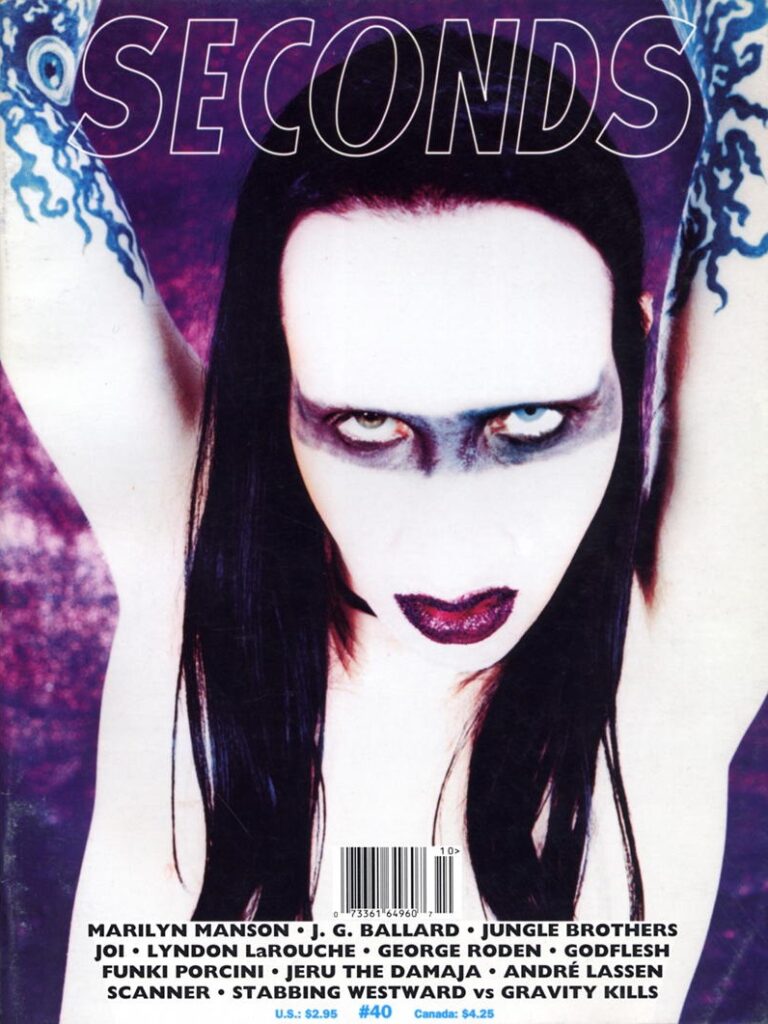
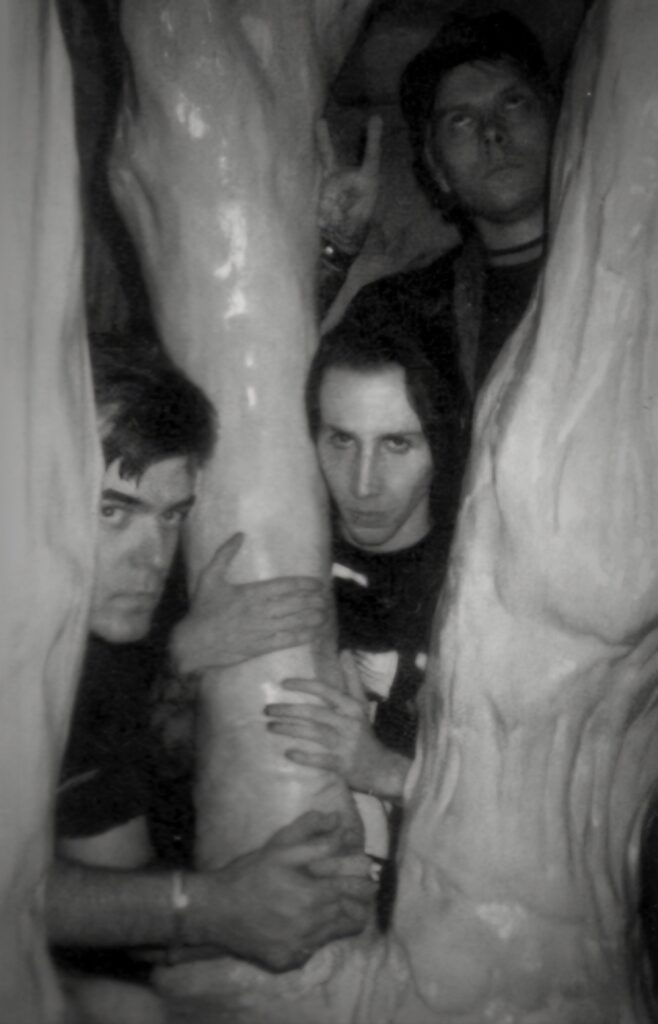
Along with a late 1990s photo of Boyd and Marilyn at Casa Bonita in Colorado, USA – featuring Manson, Boyd, and The Aither’s mutual friend Shaun Partridge in the background.
You can read the part of the interview where they discuss toys here – With more information about, and photos of, the specific toys mentioned after the excerpt. Along with some toys made in Manson and Rice’s very images as well!
With the full ‘Seconds Magazine’ interview linked at the end of this post, along with lots of other links with more information about the toys discussed.
We hope you dig it…
Bod Rice: Describe your doll collection.
Marilyn Manson: I haven’t really gotten any dolls lately. But I’ve got ‘Planet Of The Apes’ dolls, and ‘Charlie’s Angels’ – I actually have both blondes from ‘Charlie’s Angels’: Farrah Fawcett and what was it…
BR: Cheryl Ladd?
MM: Cheryl Ladd. I have both of them.
I did have a Huggy Bear doll. One of his legs fell off. That empty leg became a place where, when we were doing a lot of drugs on tour at one point, we would store the drugs in his empty leg. That’s where the term “dancing with the one-legged man” on ‘Smells Like Children’ came from, because whenever anyone was doing drugs we called it the “dance of the one-legged man.” That became a ritualistic thing that was funny for awhile.
What other dolls? A couple of Pee-Wee Herman dolls…
BR: What’s the doll with the eyes that change color?
MM: I don’t know her name, but, uh…
BR: I’ve been looking for one of those forever.
MM: They’re really hard to find. I can’t even think of what her name is, but you pull the string on the back and her eyes change color.
I have all my KISS dolls still intact.
I have a Six Million Dollar Man and the Sasquatch or whatever it was.
BR: Are there any that you’re lusting after, that you know are out there, and you can’t find them?
Toys or dolls or any weird kind of stuff like that?
MM: Yeah. Those Colorforms aliens I’ve looked for for such a long time… if you’ve ever seen them, they’re really rare. Colorforms made a series with these aliens, then they made a three-dimensional doll version of it. They’re just really hard to find.
I think my favorite doll, now that I think of it, is this Jay J. Armes. He’s like a handicapped private detective and he takes his hand off and he has different ones that he puts on. I love that because now I’m collecting prosthetic limbs and he’s kind of like the action figure of prosthetics.
BR: Have you ever seen Dolly Downs? It’s a Down Syndrome doll.
MM: No. Oh, Christ…
BR: It’s amazing.
Below we share photos of, and more information about, the toys discussed!
‘Planet Of The Apes’, Mego, 1974
Released in 1974 to tie in with the still popular to this day ‘Planet of the Apes‘ film and television franchise that began in the late 1960s. The ‘POTA’ line was a huge success for American toy company Mego. Helping to solidify their place as one of the biggest toy companies of the decade.
Plus look at how adorable their cute little furry faces are!
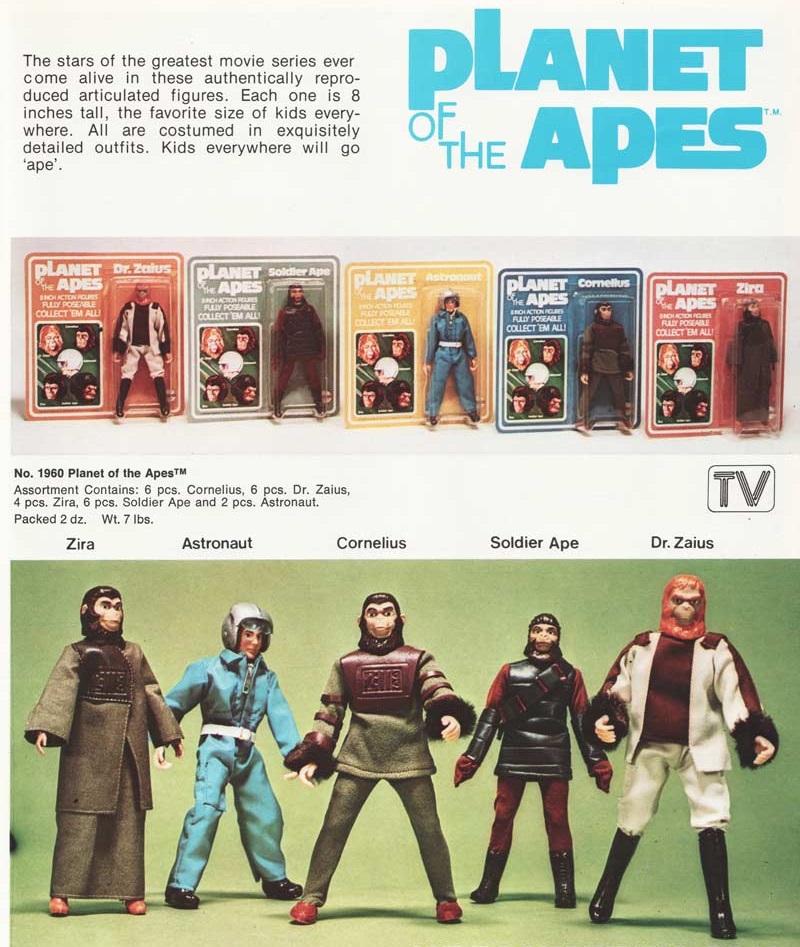
Cheryl Ladd and Farrah Fawcett from ‘Charlie’s Angels’, Hasbro, 1977
Another tie in series from a 1970s media franchise that continues to this day, Hasbro’s ‘Charlie’s Angels‘ line featured dolls, a play set, van, along with various outfit accessory packs. Including both incarnations of the Angelic Trio from Series 1 and 2 of the TV series – With matching card art to boot!
Wave 1 included Jill Munroe (Farrah Fawcett), Sabrina Duncan (Kate Jackson), and Kelly Garrett (Jaclyn Smith.) With W2 swapping out Jill / Farrah for Kristine “Kris” Munroe (Cheryl Ladd). The 2nd “blonde” in Manson’s collection.
Interestingly, and proving Ms. Fawcett’s standing and business prowess at the time, she was also able to wrangle a second license for her likeness. With Hasbro competitor Mego launching a series of 12inch Farah Fawcett dolls, accessories, and various fashion packs as part of their ‘Celebrity’ line in 1977. To our knowledge, the only instance of a celebrity having multiple figures released by competing toy companies in the same year!
Although we don’t know if the Mego version interested either Manson or Boyd.
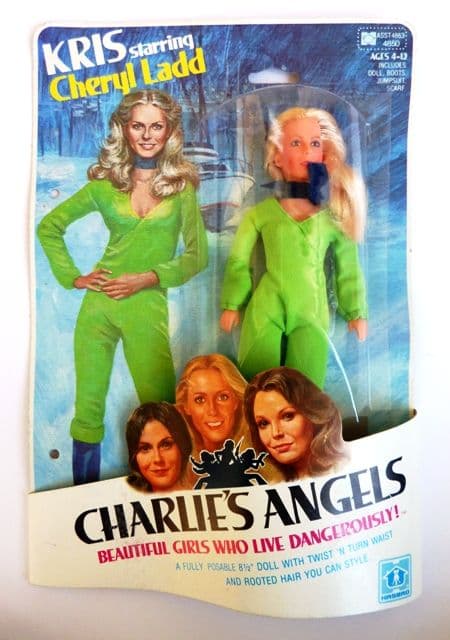
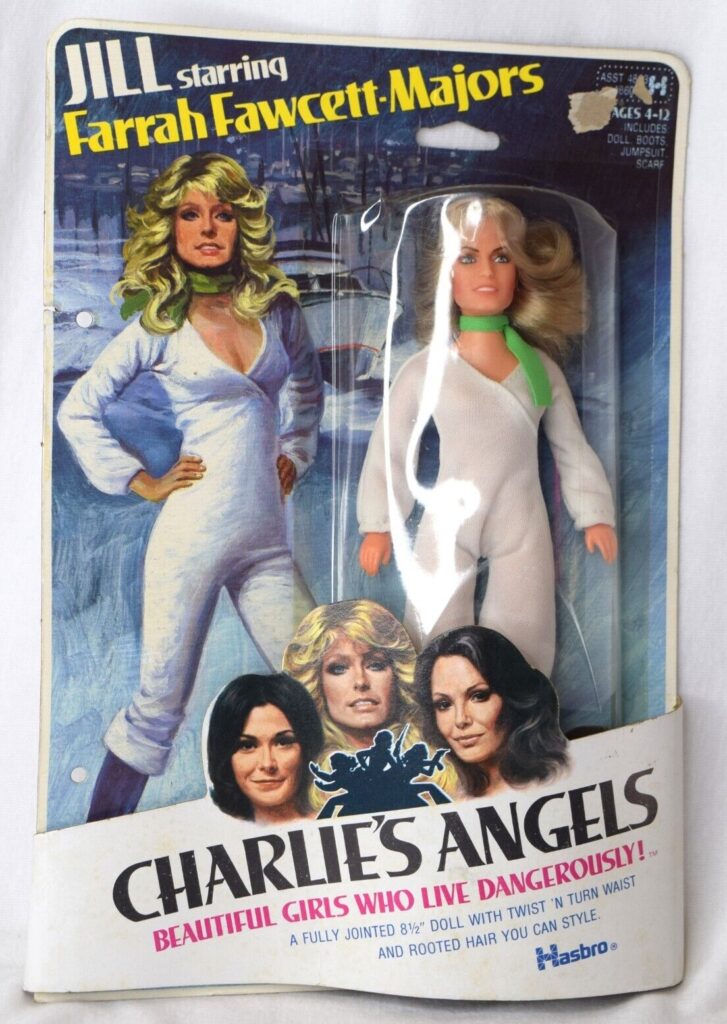
Huggy Bear from ‘Starsky & Hutch’, Mego, 1976
Another appearance from Mego toys, proving their ubiquity during the 1970s; Huggy Bear was the confidential informant character from the much loved ‘Starsky & Hutch‘ television show. Played by actor Antonio Fargas.
With Huggy Bear quickly becoming a much loved part of pop culture at the time, and remaining so to this very day! With Snoop Dogg playing Huggy Bear in the 2004 remake film.
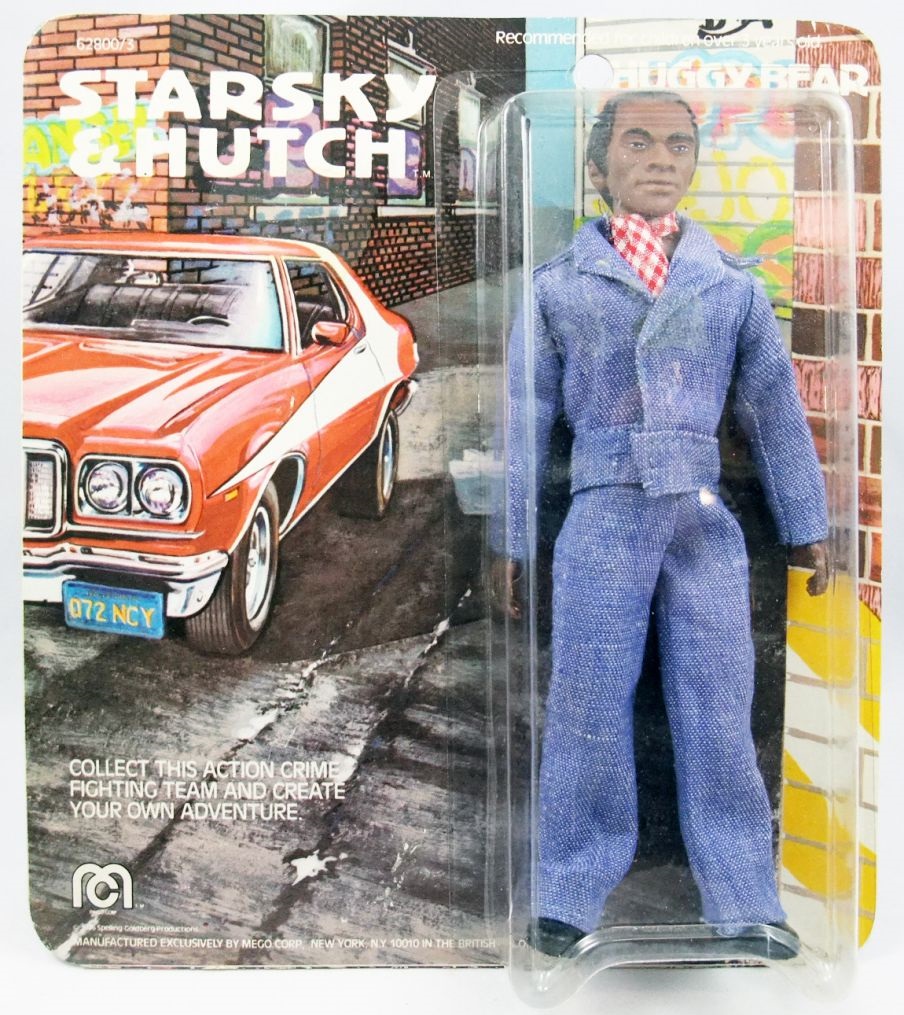
Pee-Wee Herman, Matchbox, 1987
The creation of actor, comedian, and writer Paul Reubens; Pee-Wee Herman debuted in 1979 on aptly titled television dating show, ‘The Dating Game‘; gaining further exposure in a rather raunchy live action stage show in 1981. With Paul and Pee-Wee going on to their big break as star of children’s show ‘Pee-Wee’s Playhouse’, which ran from 1986 to 1990.
Indeed ‘…Playhouse’ was such a success that it quickly spawned a plethora of tie in toys and merchandise. The most iconic being the 17inch Talking Pee-Wee, from Matchbox’s tie-in Pee-Wee line. With the doll spouting classic Pee-Wee phrases such as “I know you are, but what am I?”, “Arrggh!”, and “Hey what’s that? Made you look!”
A toy nerd himself, Mr Reubens demanded the talking doll include the at-the-time outdated pull-ring-to-talk mechanism, originally popularised back in the 1950s. Greatly annoying business executives due to the increased production costs, and thus lack of profits this would cause. However, the executives gave in, and the toy was produced to Reuben’s specifications – Helping to cement its status as one of the most memorable toys of the 1980s!
Sadly, just like the ring pull talking toys of the mid century that Reubens lovingly referenced, the Talking Pee-Wee doll’s voice mechanism was prone to breaking, leaving the doll silent. An oddly poignant metaphor for Reuben’s recent passing…
In addition to the doll, Matchbox also released various standard sized toys, ventriloquist dolls, wind ups, large toys, and even a very memorable playset. Due to the large range, we can’t be sure what specific Pee Wee toys Manson is mentioning in the interview… Maybe ask him yourself if you ever get a chance?
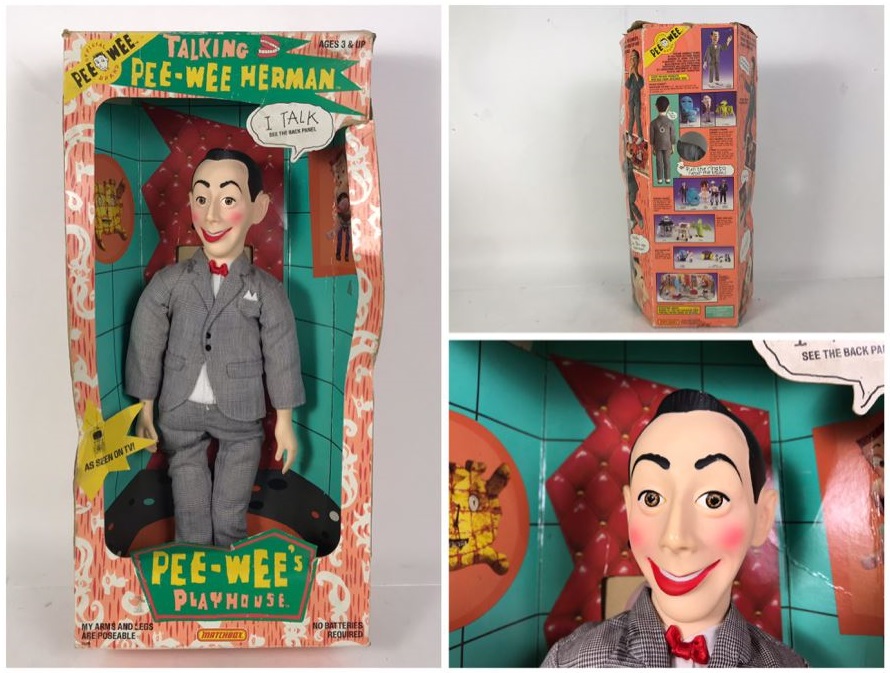
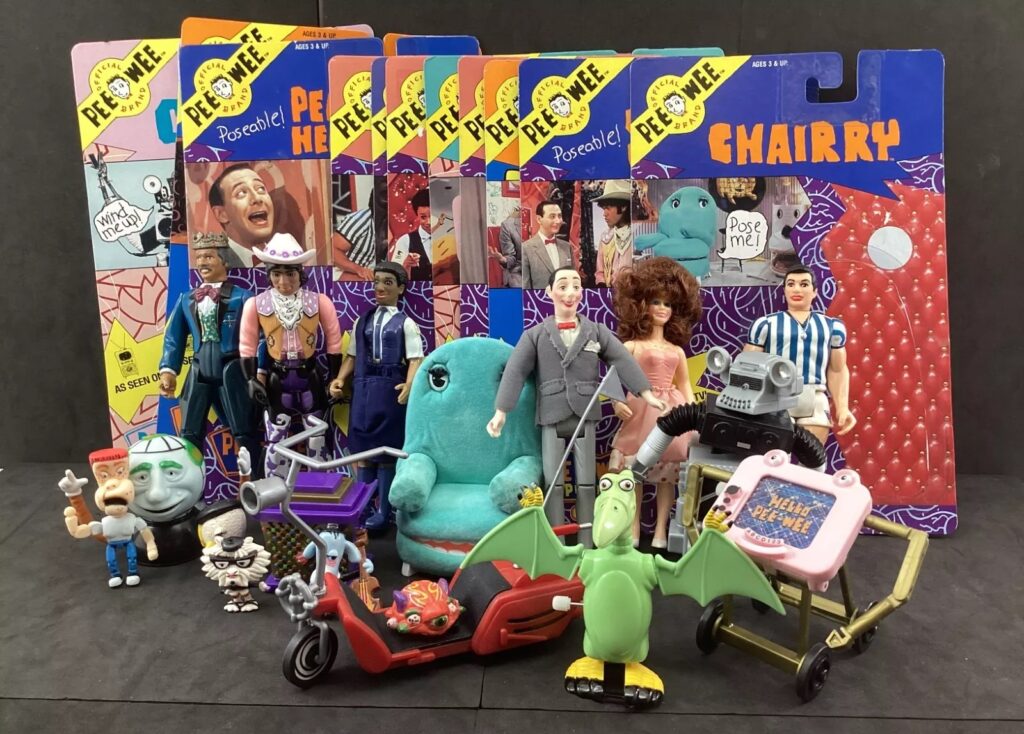
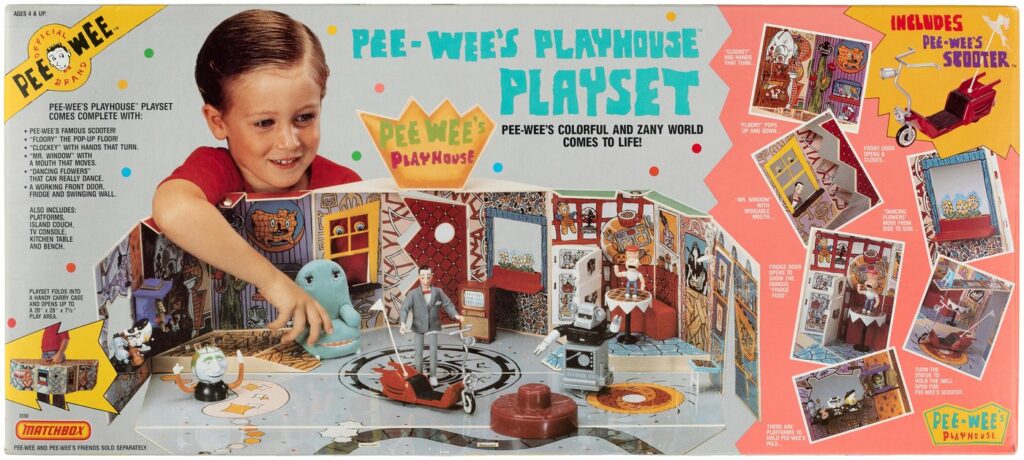
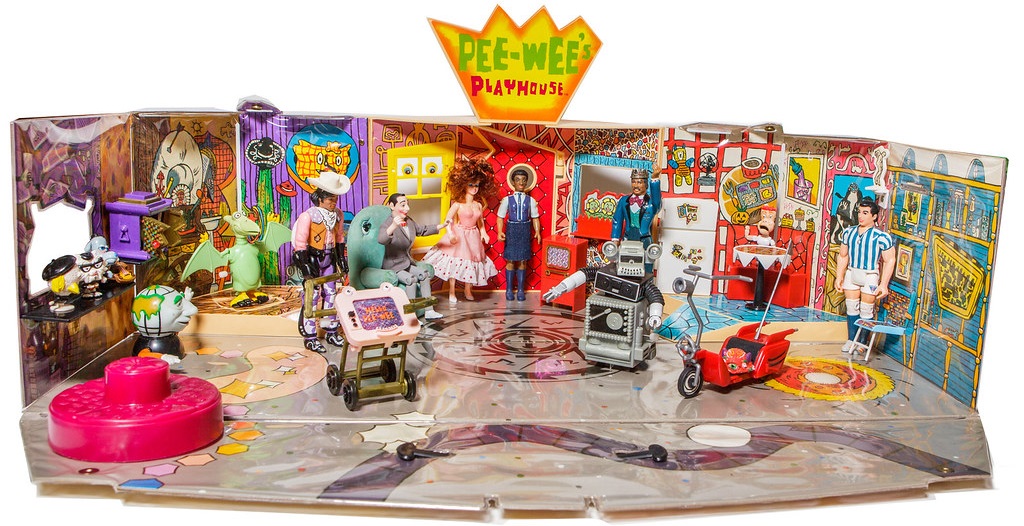
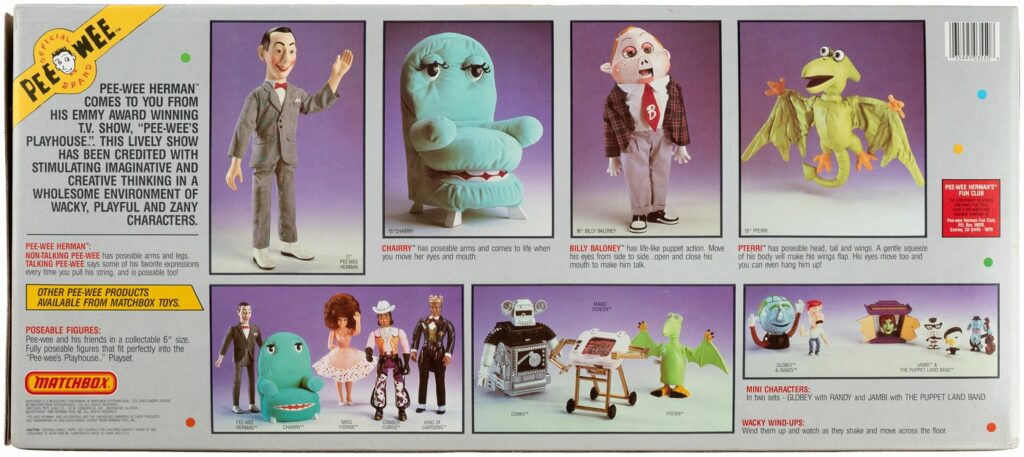
Blythe, Kenner, 1972
The doll whose eye changes colour discussed by the gents above; Blythe marks a rare appearance on this list of a stand-alone toy not based on any pre-existing media franchise. Released in 1972 by Kenner, Blythe has a memorable and iconic groovy look that also capitalised on the “big eye” trend of the late 1950s to early 1970s – exemplified by the paintings of Margaret Keane.
However, the doll’s unique look is said to have been rather off putting for many children and their parent’s; with Blythe only being produced and available for a short time during its initial release as a result.
But fear not, as Blythe would have her eventual rebirth! Being featured in a very popular photo book by Gina Garan, called ‘This is Blythe‘, in 2000. With the book eventually leading to Blythe being discovered by businesswoman Junko Wong, who fell in love with the doll and oversaw her 2001 re-release by Japanese toy company Takara.
With Blythe still being released, and having countless fans, to this day! Their is even a creative and devoted community of fans and artists who make their own custom Blythes, clothing, and accessories. A world we very much recommend checking out.
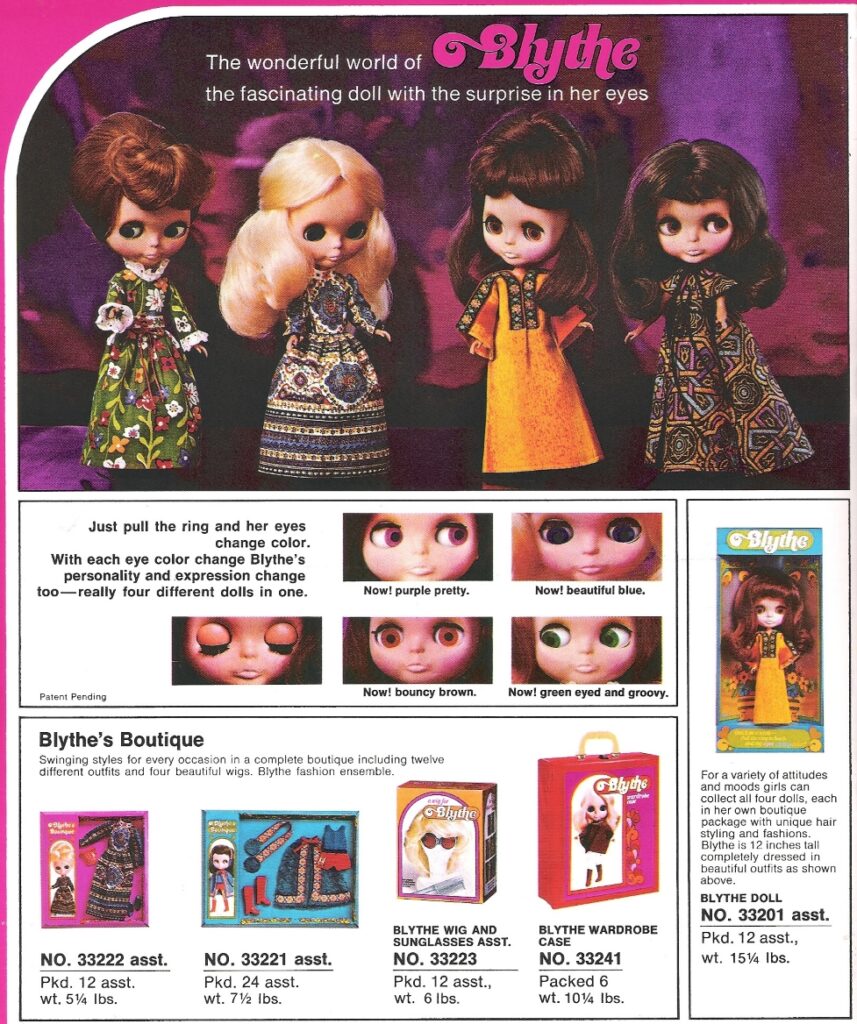
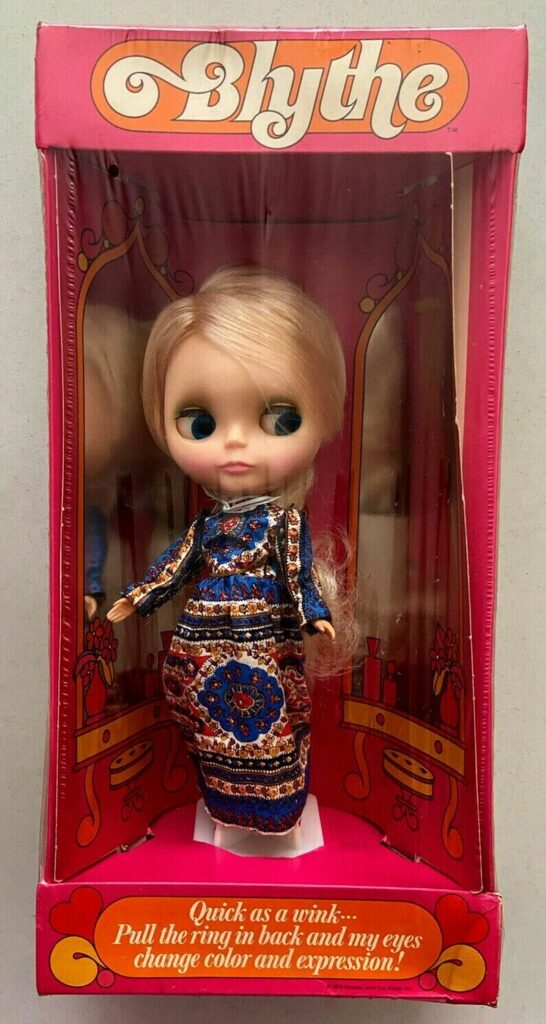
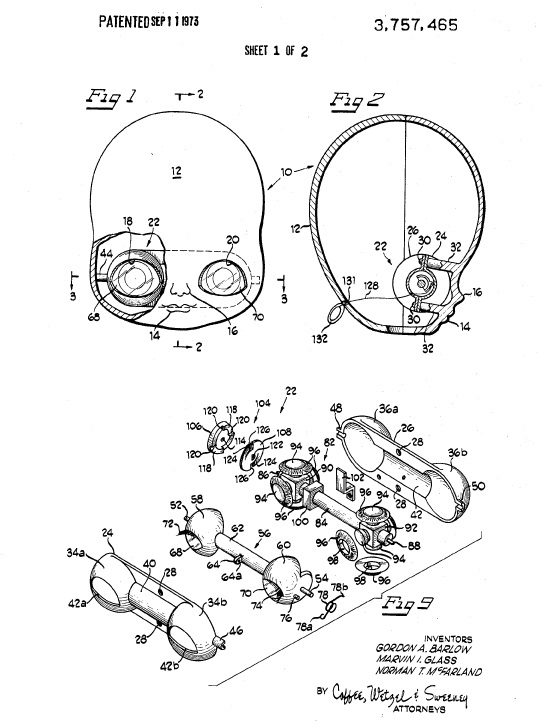
KISS, Mego, 1978
An early item in the tidal wave of KISS memorabilia to come over the years, Mego’s line of 12inch KISS dolls represent some of the earliest toys we know of, based on a rock n roll group. With the dolls being released in two versions – skinny and muscle. The slim version being noticeably smaller, with fewer joints, and was only available for a short time, upon the series’ initial release, due to KISS and their management asking for a redesign.
With KISS being such an important player in music, heavy metal, pop culture, and even fashion – It’s no wonder Manson is a fan of the band, and their toys! Hell – So are we.
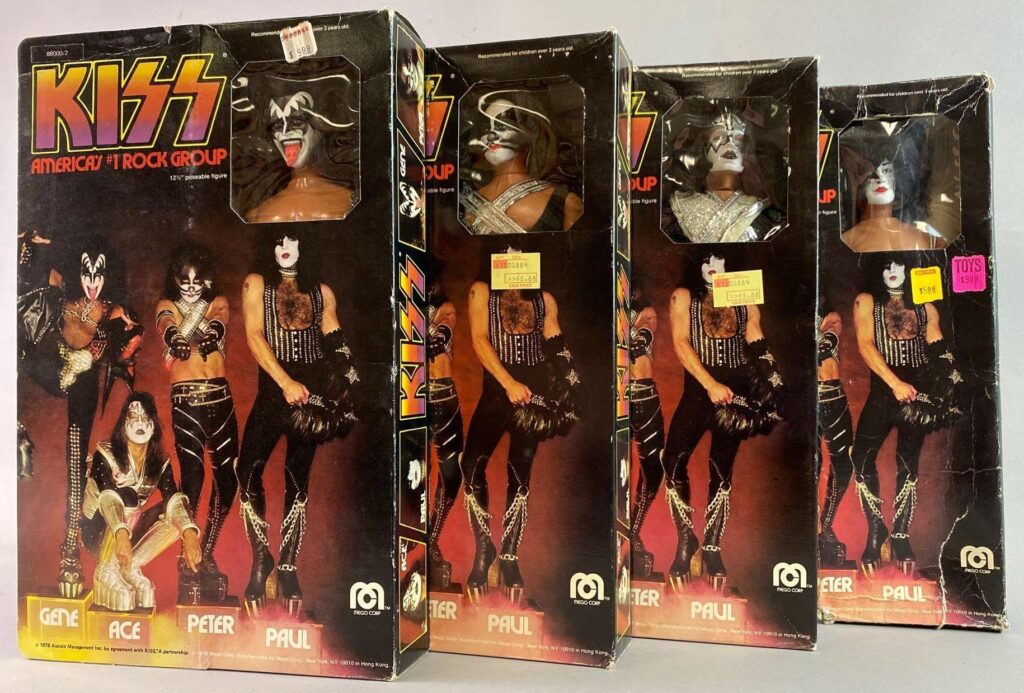
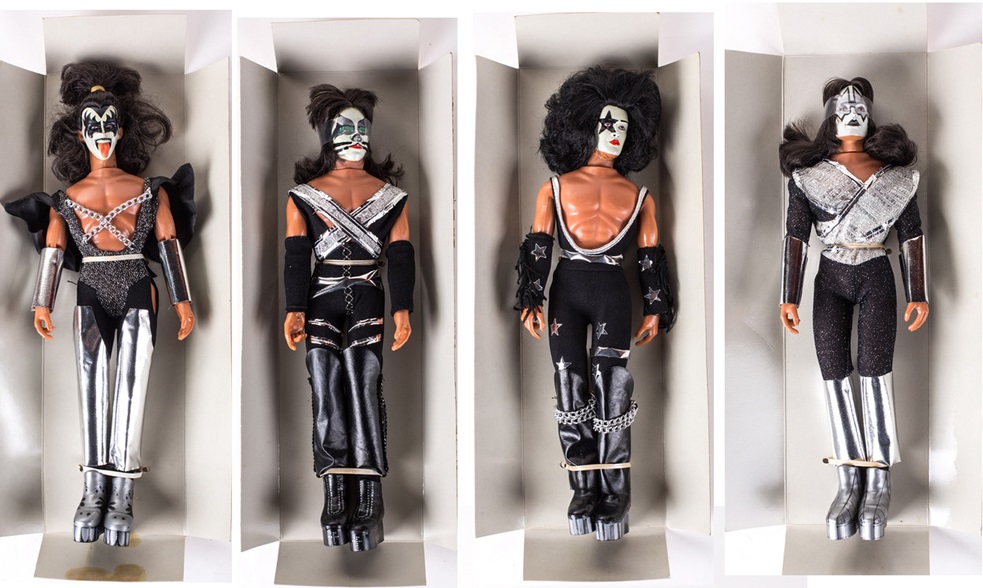
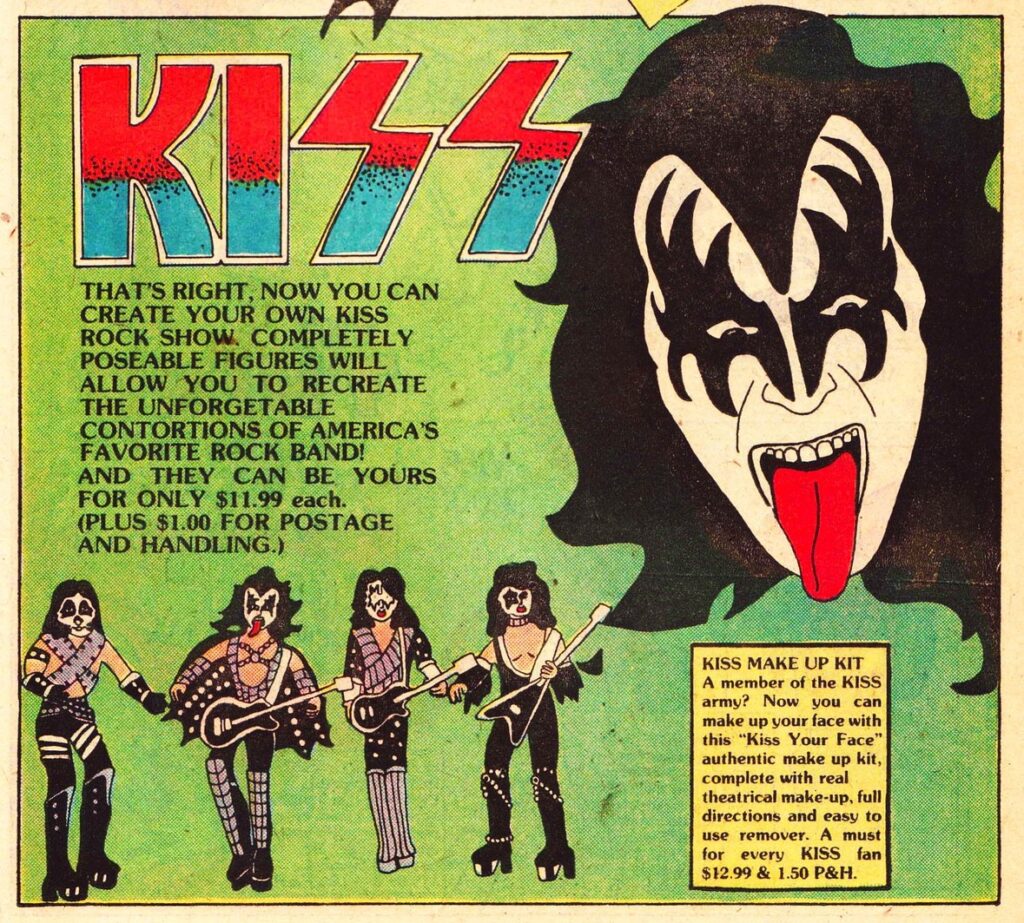
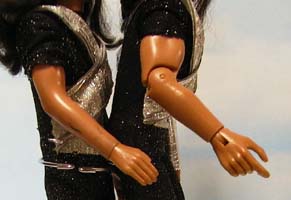
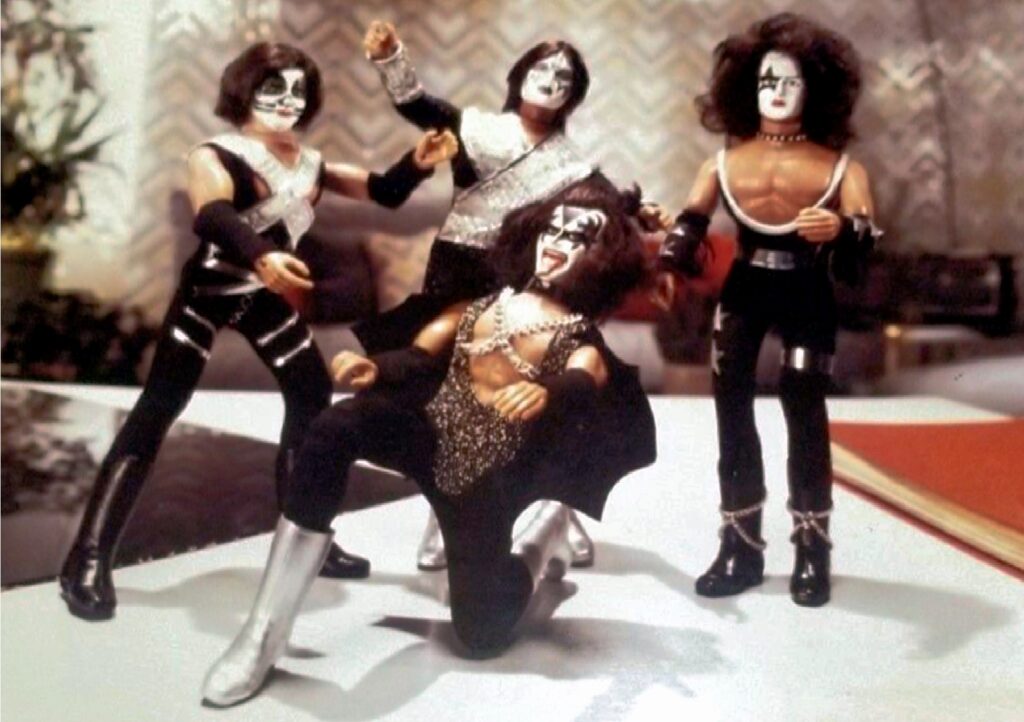
Six Million Dollar Man & Bigfoot, Kenner, 1973
Two figures from Kenner’s 1973 tie in line to the hugely popular ‘Six Million Dollar Man’ TV show (1973 to 1978), starring Lee Majors as Steve Austin, the Sim Million Dollar Man. An injured spaceman reborn using the wonders of technology to create a super powered human / machine hybrid. The 13inch Steve Austin doll included lots of features, including his bionic eye, and various sold-separately-accessories. The Bigfoot villain character however, only came with a pop-off chestplate.
With Kenner’s line also featuring various figures, vehicles, playsets, and outfits for Steve – Including the very strange and awesome ‘Duel Launch Drag Set’ seen below.
Famously Lee Majors was also married to Farrah Fawcett at the time of the ‘Six Million Dollar Man’ show, and the dolls’ release. Enabling kids at the time (and adults today) to re-enact Lee and Farrah’s marriage using their associated dolls. You could even use other toys as characters to act as family members, home-wreckers, assorted hangers on, or anything one’s heart desired!
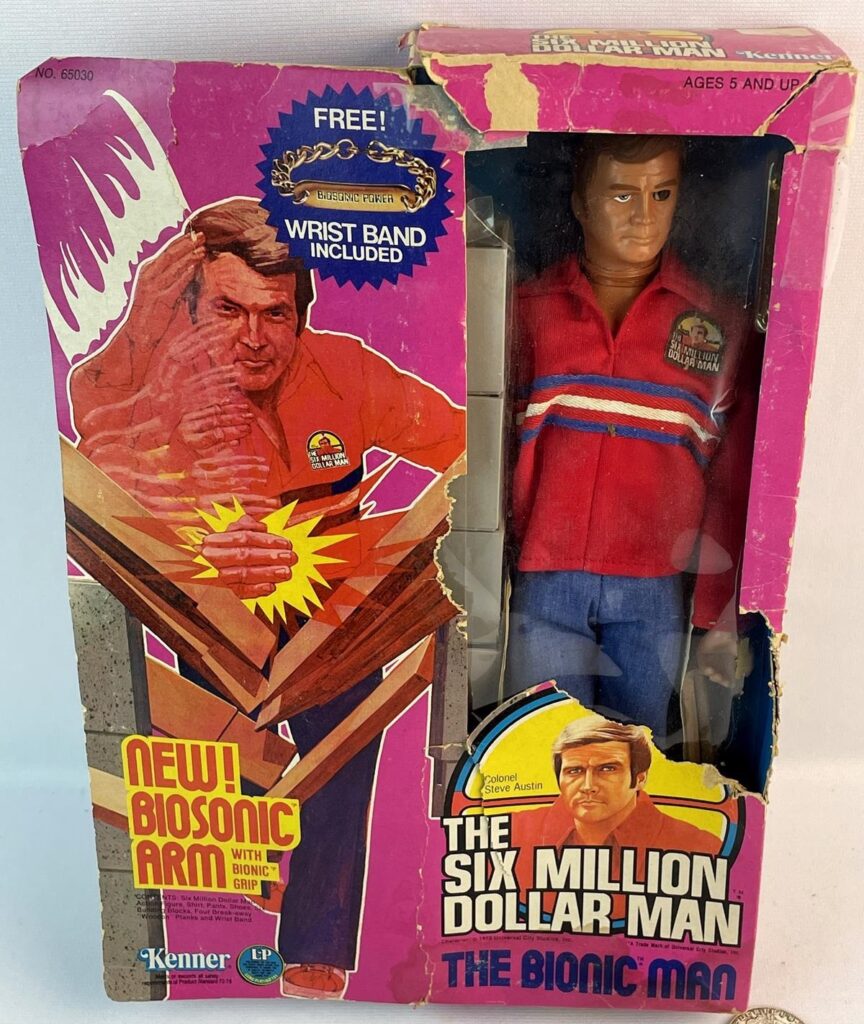
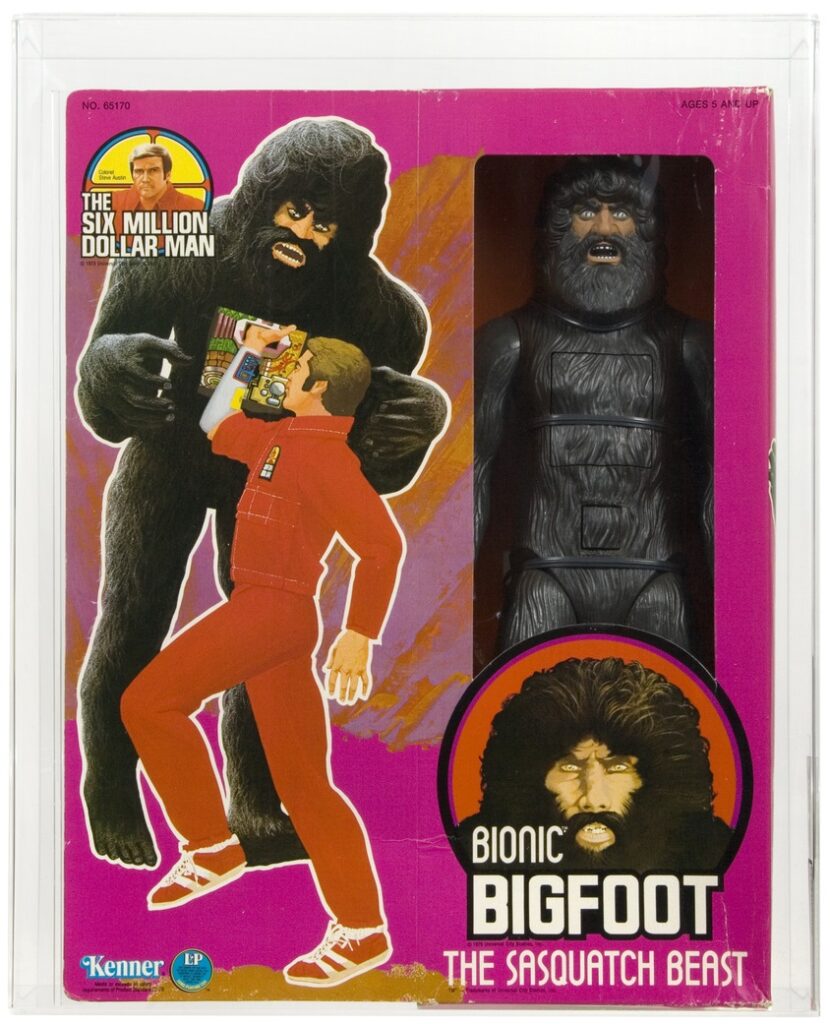
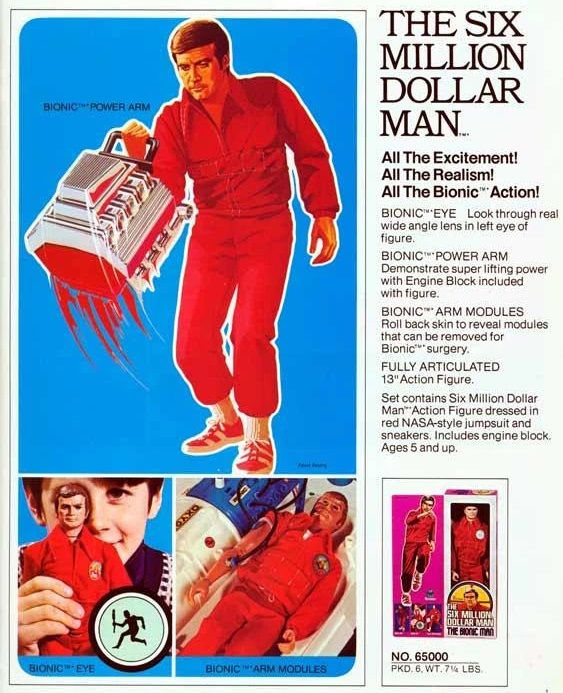
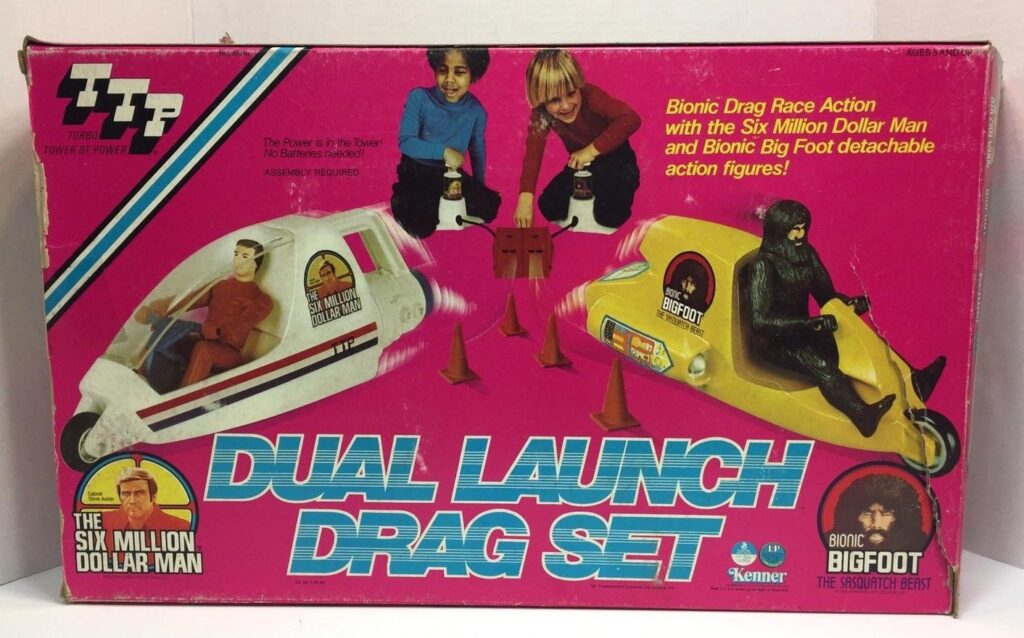
‘Outer Space Men’, Colorforms, 1968
Designed by much loved toy creator and collector Mel Birnkrant, ‘The Outer Space Men’ line was released in 1968 by Colorforms, at the height of the Space Craze. Which coincided with humanities’ early space exploration in the 1950s, and America’s eventual Moon Landing in 1969. With the series featuring 7 characters in total: Alpha 7, Electron, Xodiac, Orbitron, Commander Comet, Astro-Nautilus, and Colossus Rex.
Similarly to Blythe, discussed above, ‘The Outer Space Men’ were not a success at debut, but have gone on to become much loved toy classics – With the series being reissued over the years as standard action figures, and even made in Japan sofubi / soft vinyl. Beginning with toy company Four Horsemen Studios, who partnered with Mel to revive the line in 2008.
An interesting fun fact is that ‘The Outer Space Men’s’ creator, Mel Birnkrant, is directly linked to Manson and Rice’s mutual friendship with Church of Satan founder Anton LaVey. As Mel was close friends with occultist and filmmaker Kenneth Anger, himself a close friend and collaborator of Mr. LaVey’s! Indeed, Kenneth even directed and released a film about Mel’s vintage toy collection – 2004’s ‘Mouse Heaven.‘
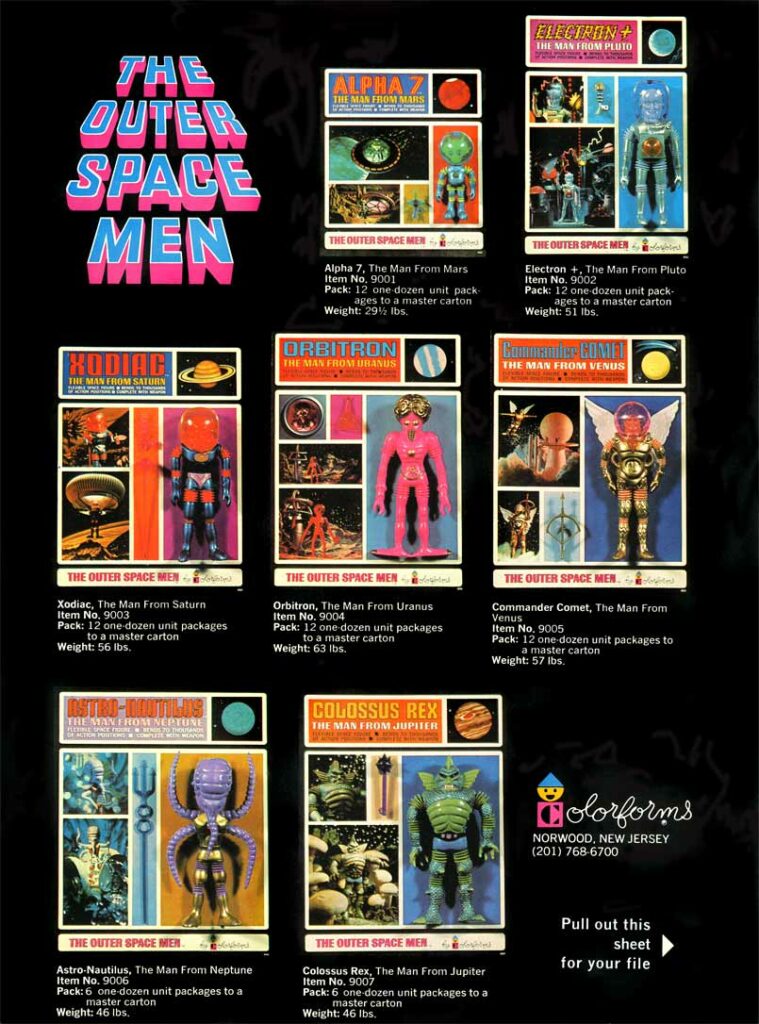
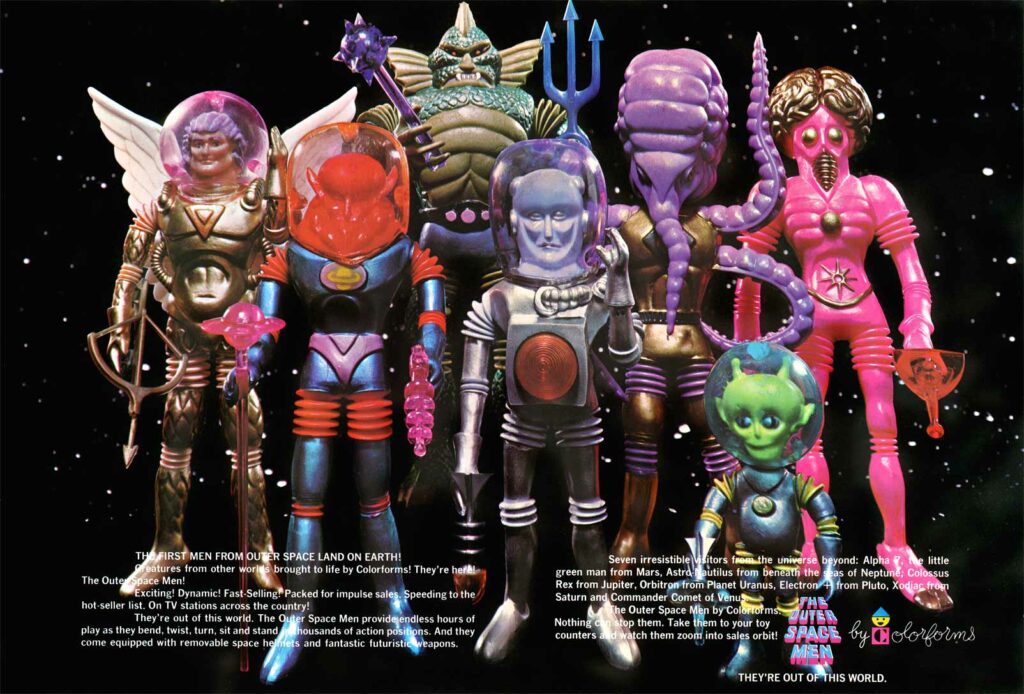
Jay J. Armes, Ideal Toy Corp., 1976
Still alive today at the age of 92, Jay J. Armes is famous due to his private eye skills, and personal story – Loosing his hands in a childhood accident with some railway torpedoes, having them replaced with prosthetics, refusing to succumb to depression, and instead developing both his body and mind into a crime solving machine!
With Jay J gaining his initial fame in 1972 though his work solving the kidnapping of iconic actor Marlon Brando’s son, Christian. With the media at the time dubbing him, “the real life Six Million Dollar Man,” due to his feats and prosthetics – and just like the fictional Steve Austin, the very real Jay J. Armes was also immortalised in toy form, by Ideal in 1976. With Ideal’s line featuring Jay J, along with a training room playset, and mobile investigation unit vehicle.
Jay J. Armes – What a character, and what a toy!
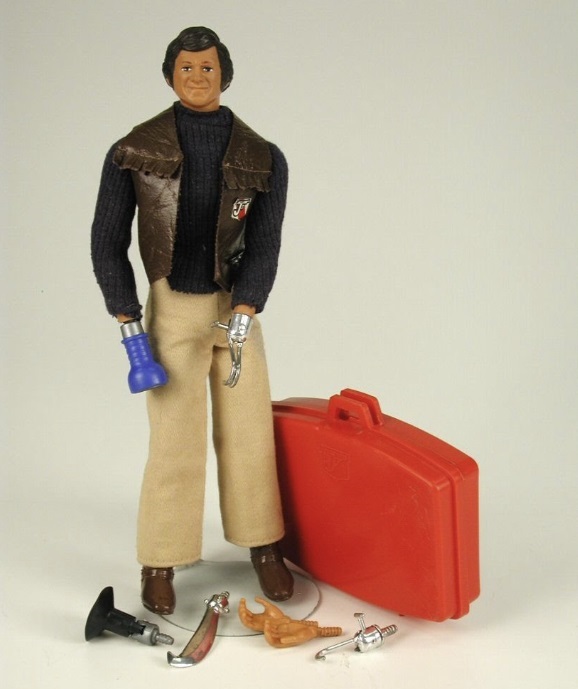
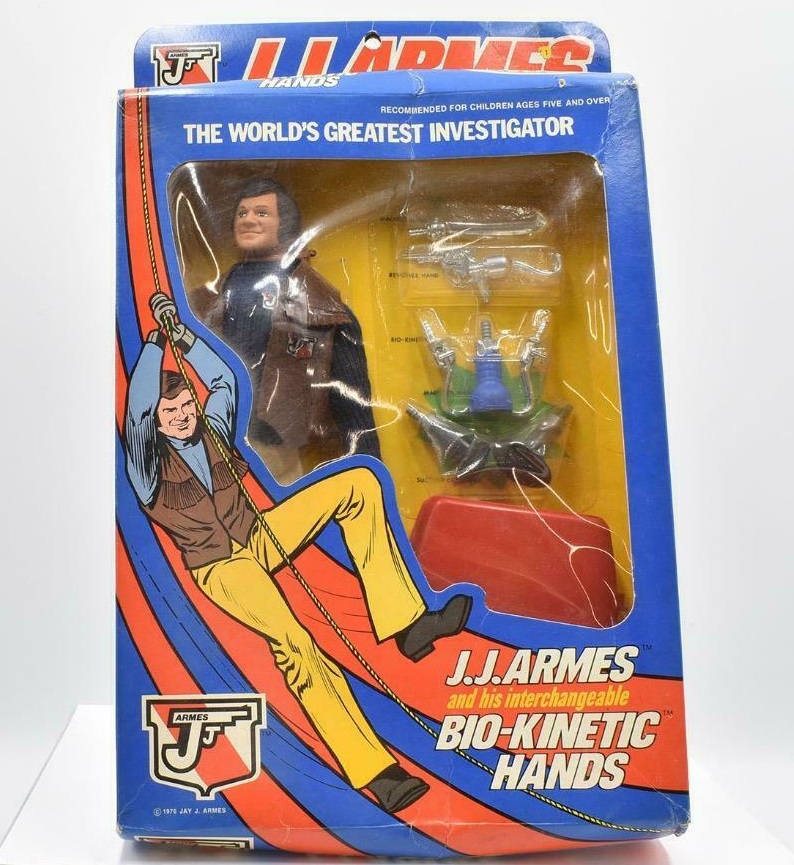
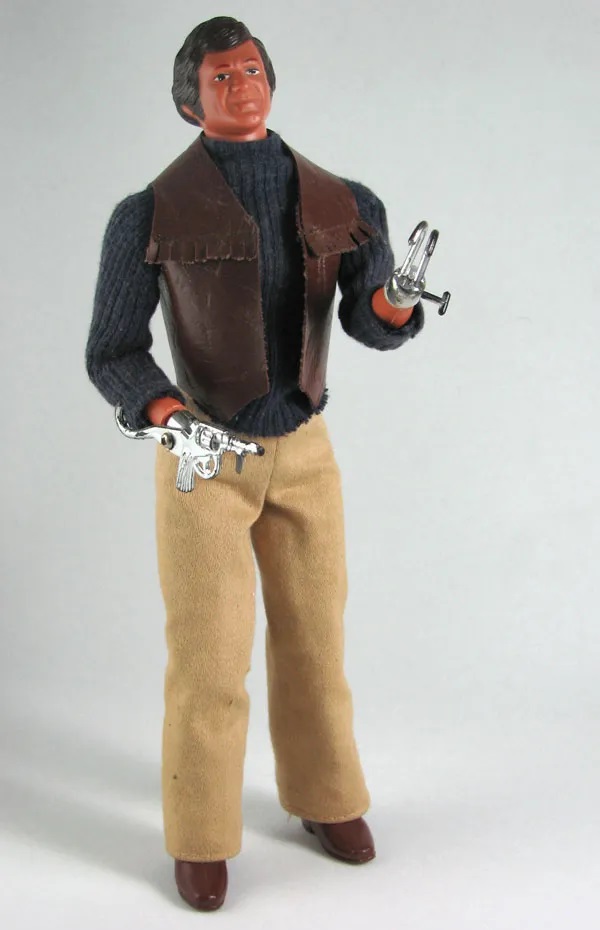
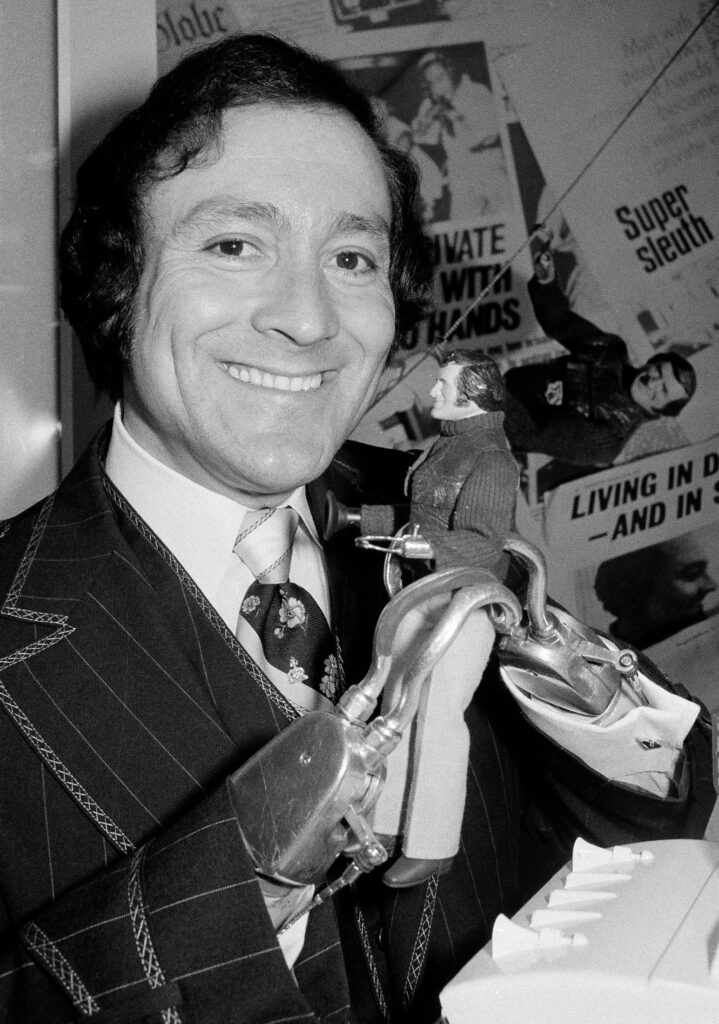
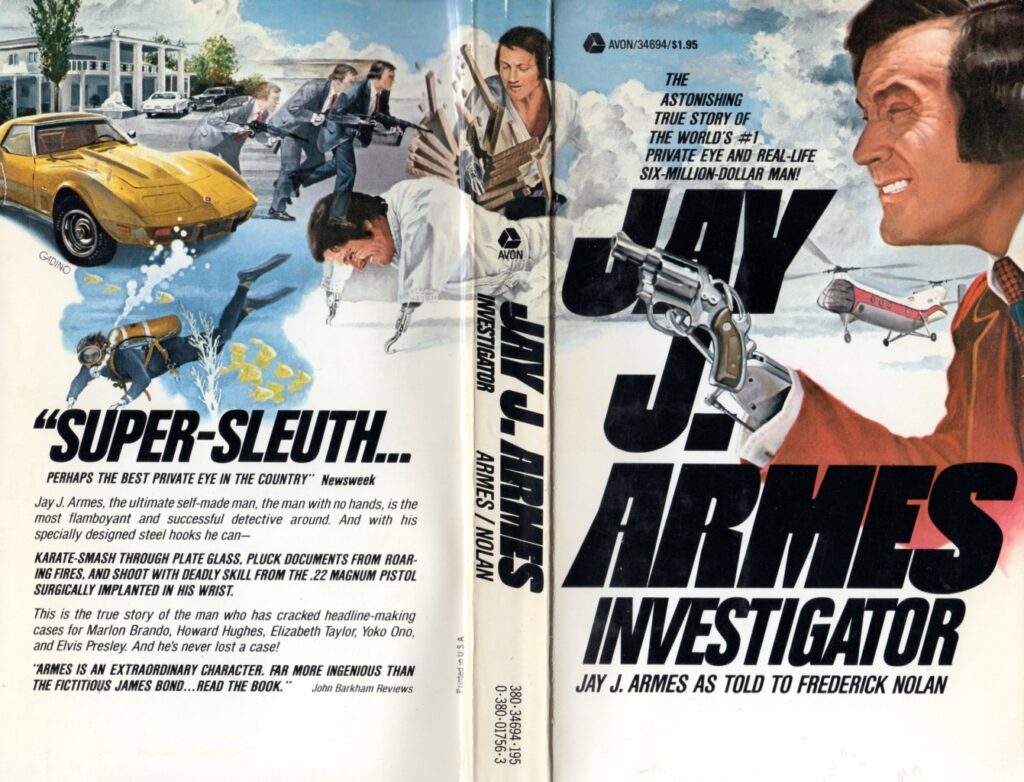
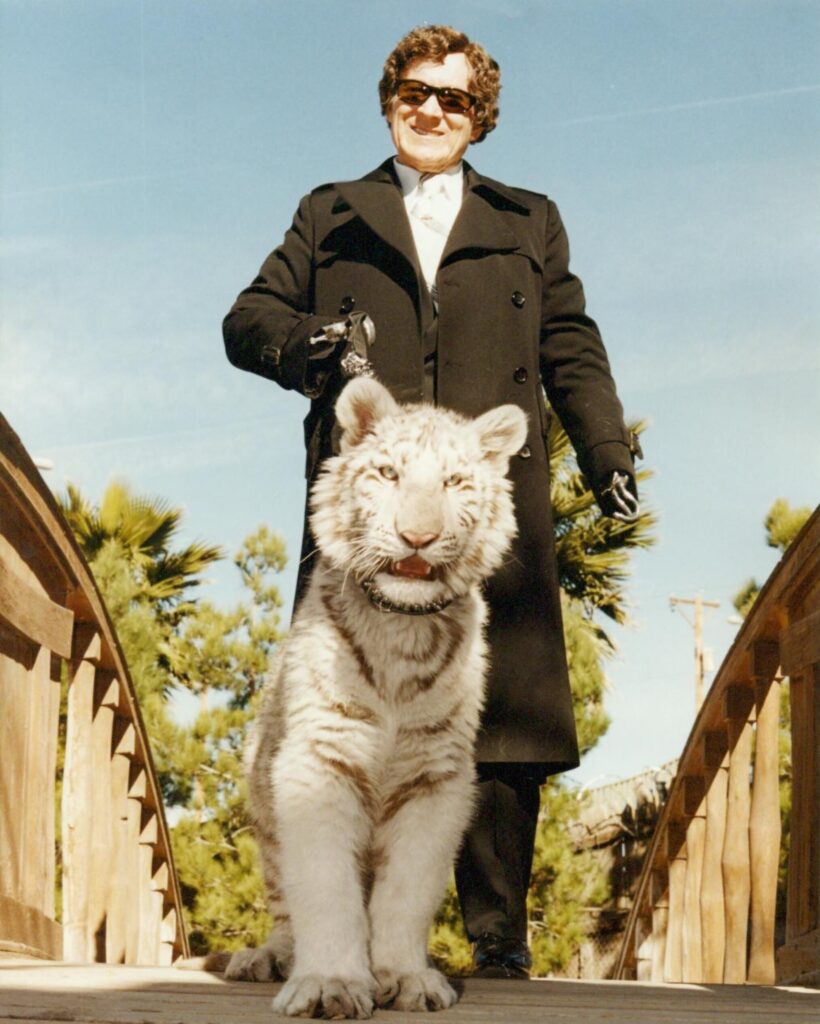
Dolly Downs, Camp Ventures Inc, 1992
An early and pioneering example of inclusivity, Dolly Downs was released in 1992 by Camp Ventures, an American charity for the developmentally disabled. The brainchild of child psychologist John Lukens, whose wife Kathleen Lukens was principal founder of Camp Ventures, Dolly Downs was envisioned as a plaything for kids with or without down syndrome. To build self-respect and awareness.
With Dolly being available in two versions, white or black, and coming with an accompanying cassette in which Dolly shares her tale. Saying such things as,
“I may be a little different from some other children, but I’ll be your friend. You can show me how to do the things that you do. Give me lots of time and lots of love, and you’ll see.”
With Dolly’s voice played by Kathleen’s at-the-time 9 year old granddaughter, Rebecca.
Importantly, Dolly was also assembled by developmentally disabled workers as part of Camp Venture’s skill building workshop and job programs. With proceeds going directly back to the workers and the charity. Bringing the inclusivity full circle!
[We have also heard that Dolly Downs was so popular that a male version was eventually released, though we couldn’t find further info on him at the time of publication.]
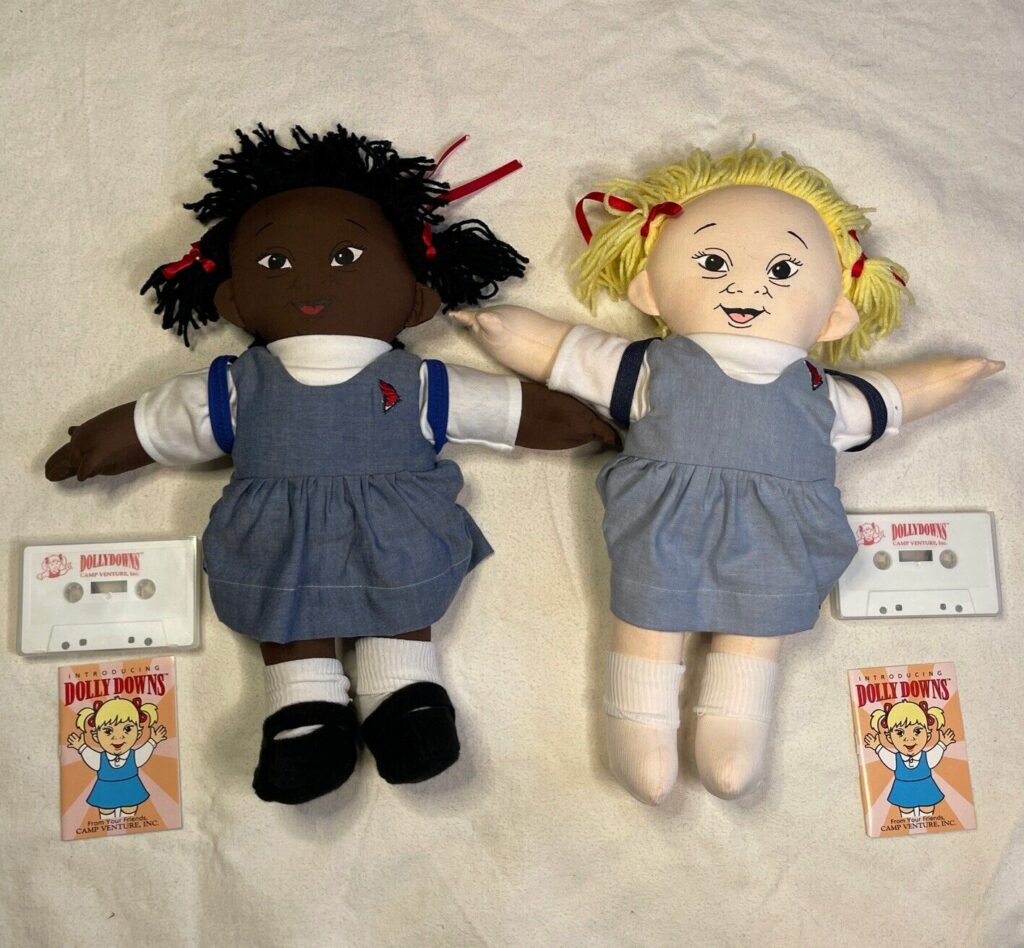
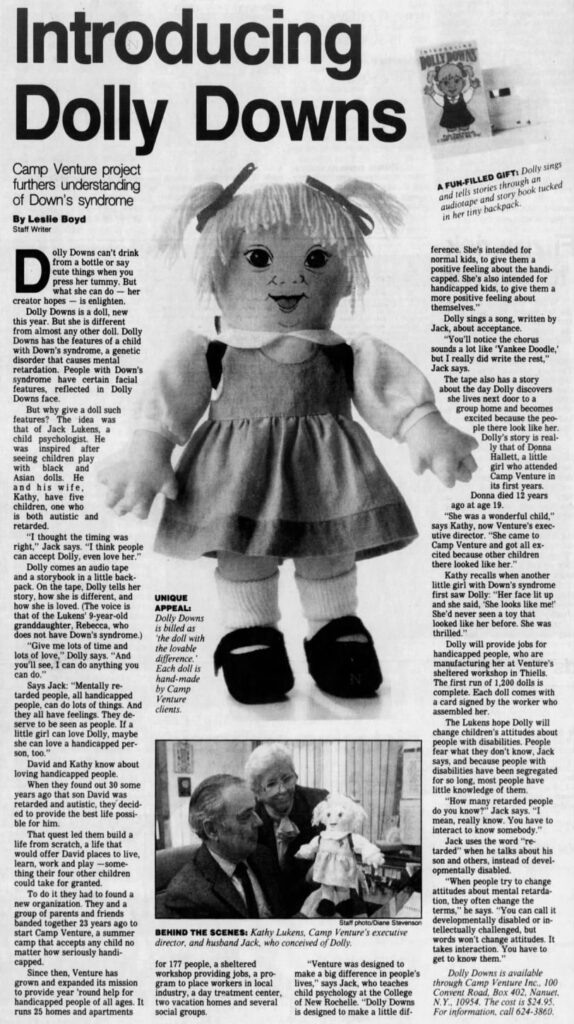
Marilyn Manson, Fewture, 2001
Further proving his toy nerd status; in 2001 Manson would go on to oversee the creation of toys in his very likeness! However, far from settling for the usual quick cash-in, Manson insisted his toys be of the utmost quality – Collaborating with Japanese manufacturer Fewture on a series of 4 action figures, and 2 stylised wind-up-walkers.
Released from 2001 to 2003; they are designed by Yasushi Nirasawa and sculpted by Yoshihiro Saito. True works of toy art indeed!
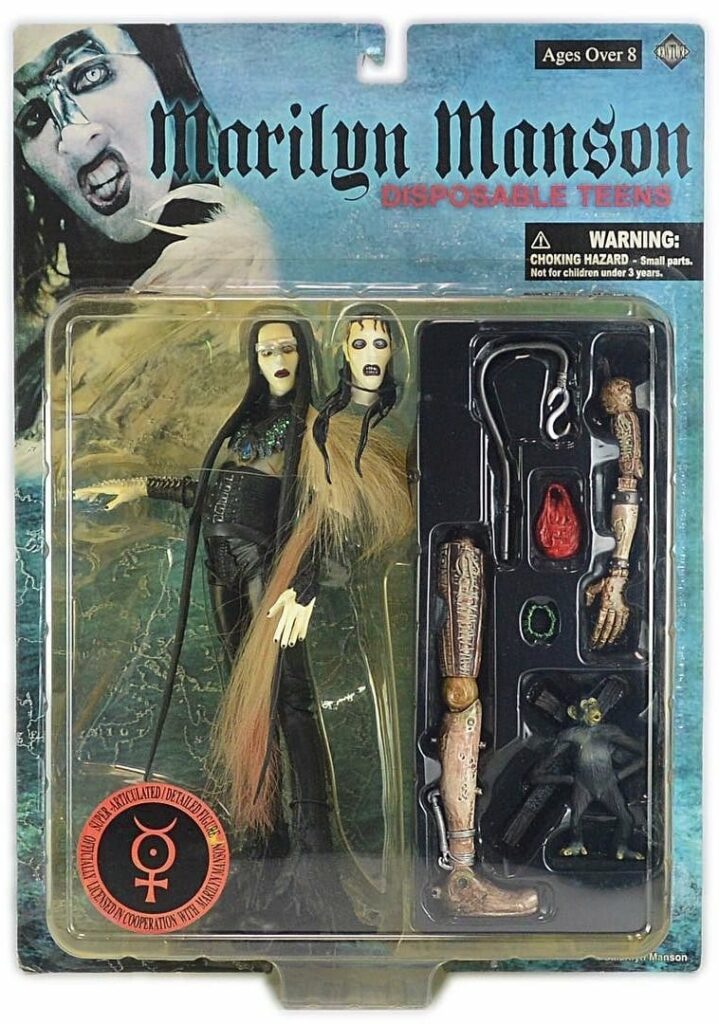
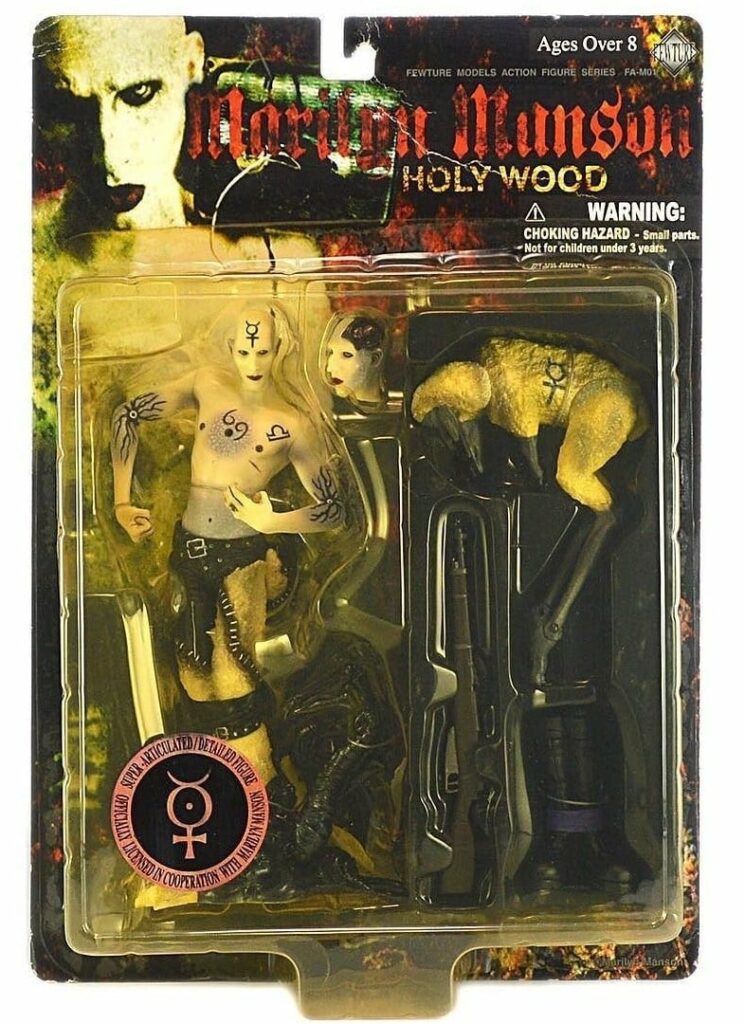
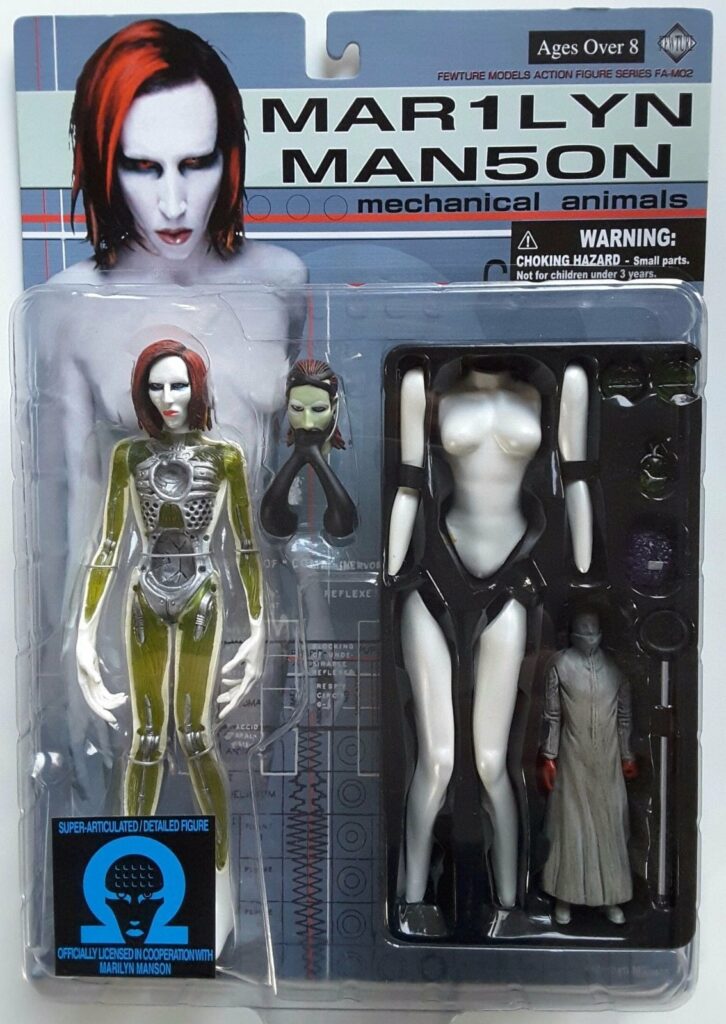
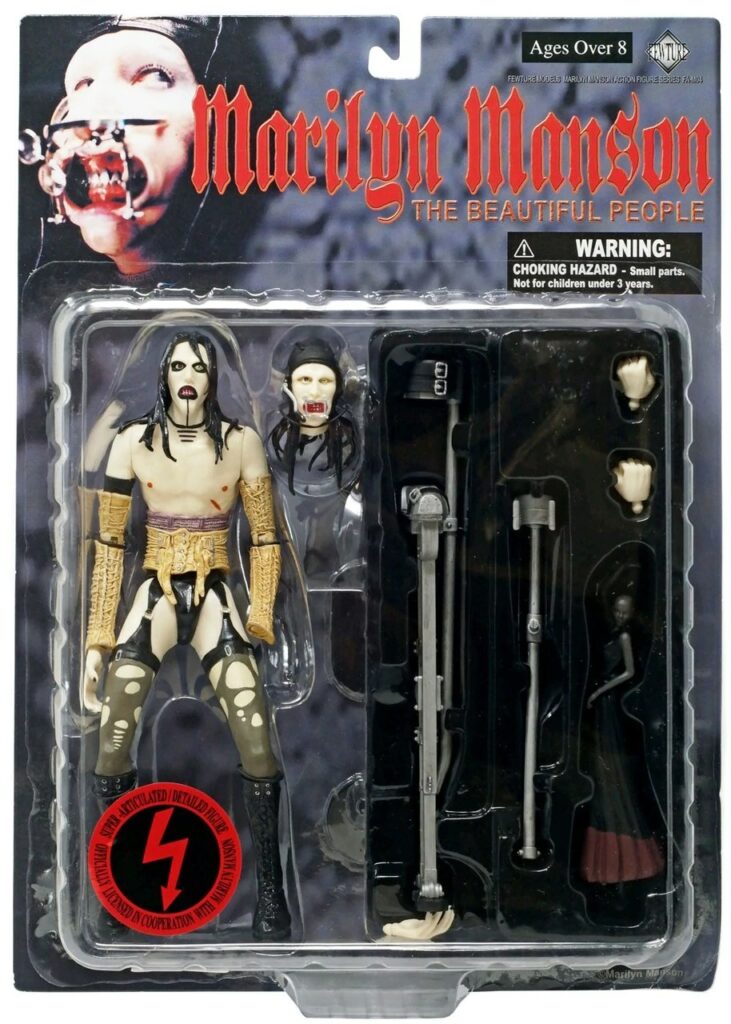
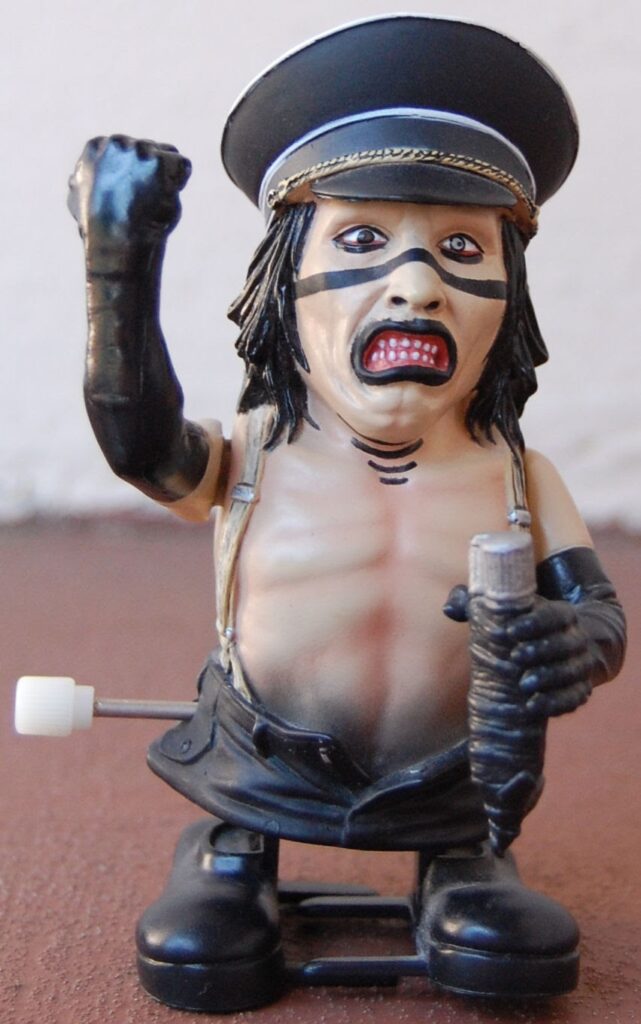
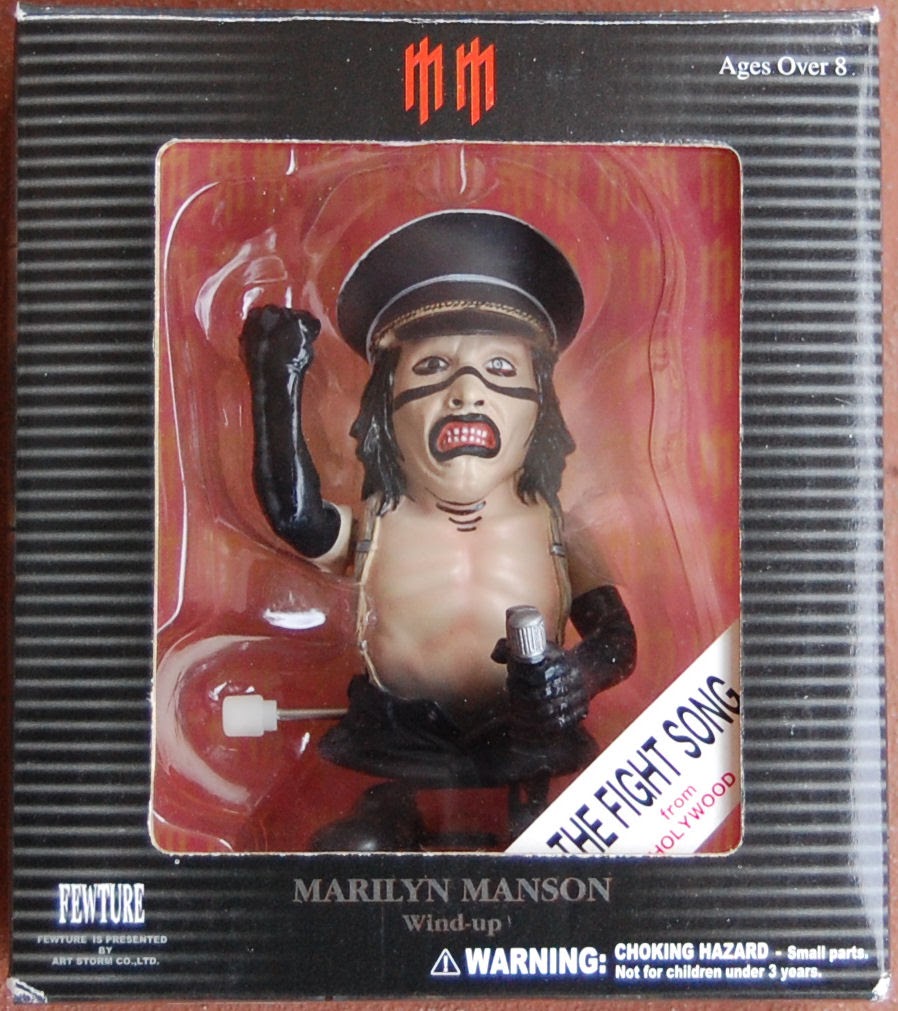
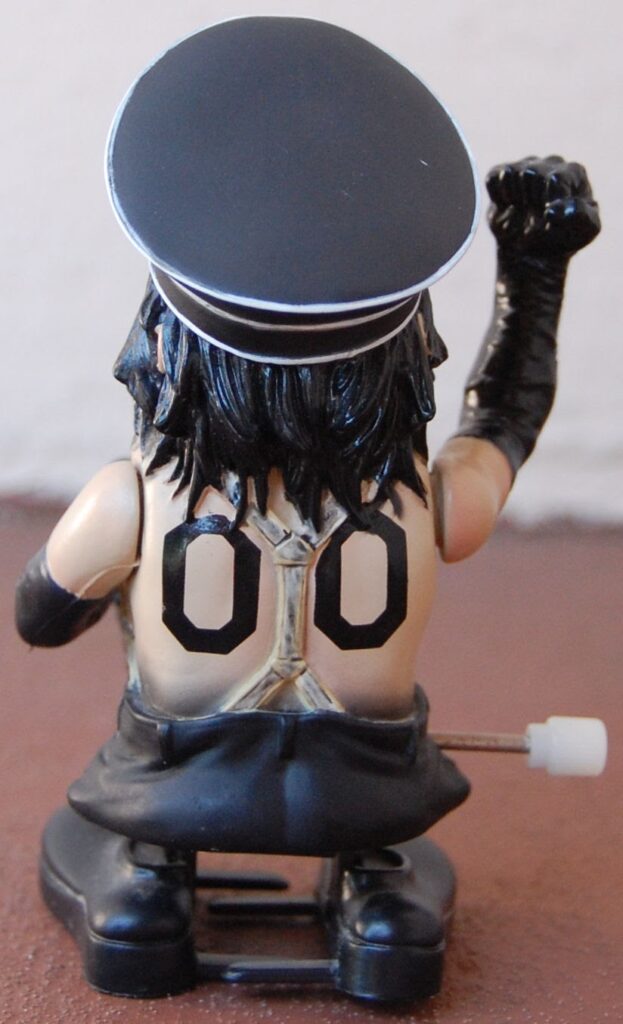
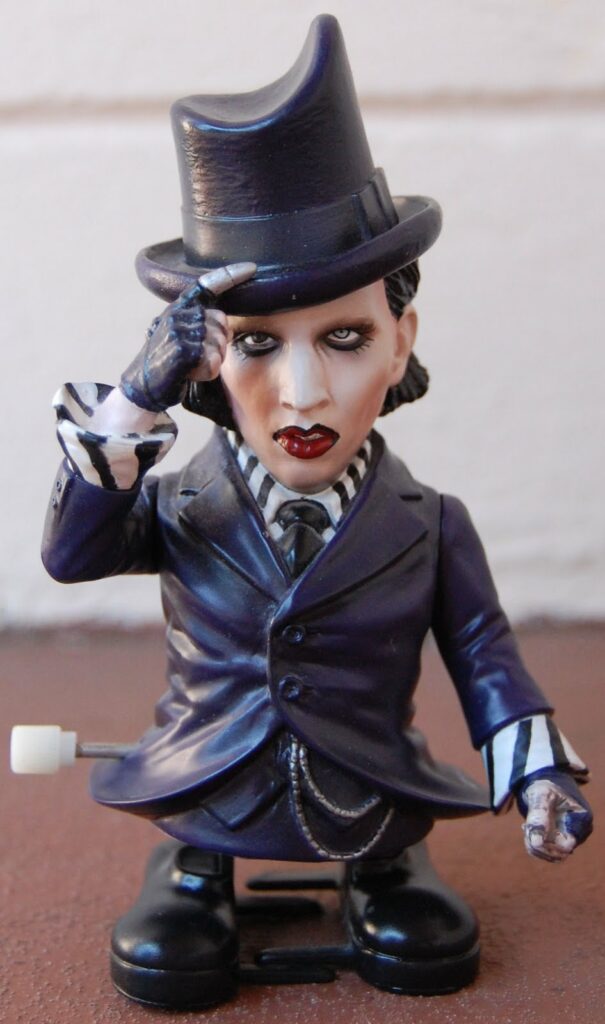
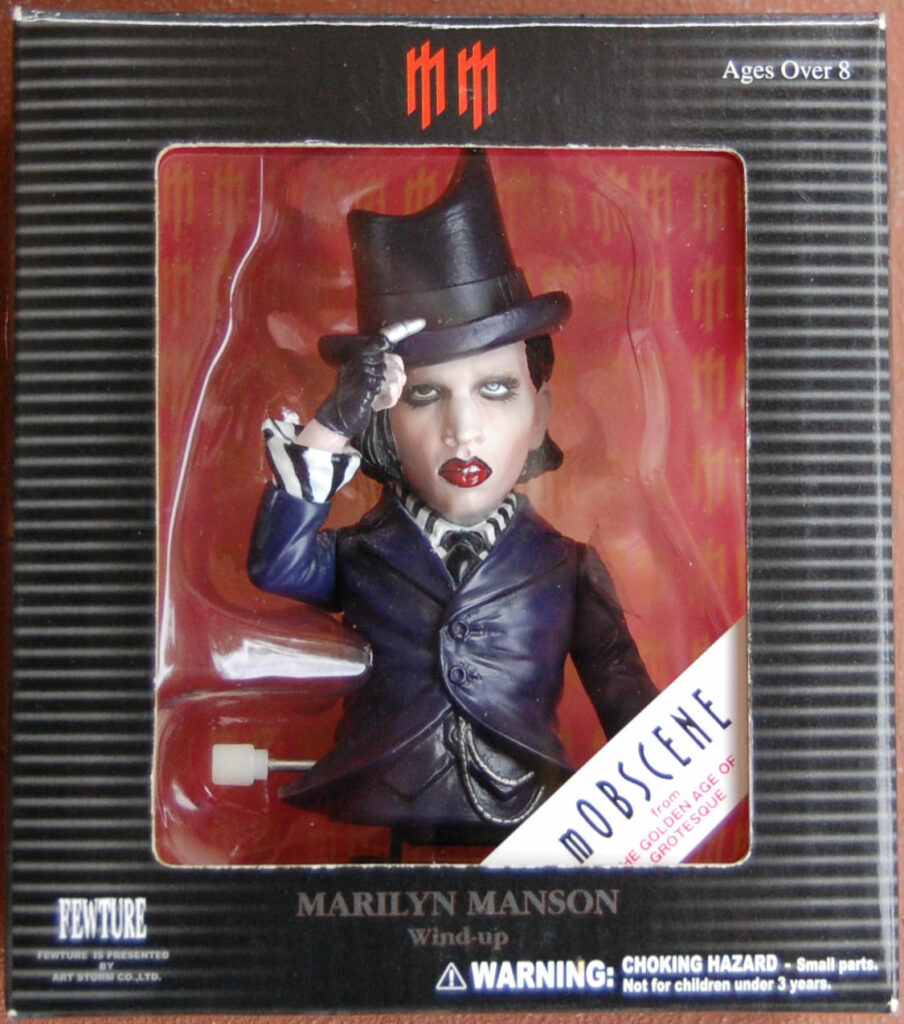
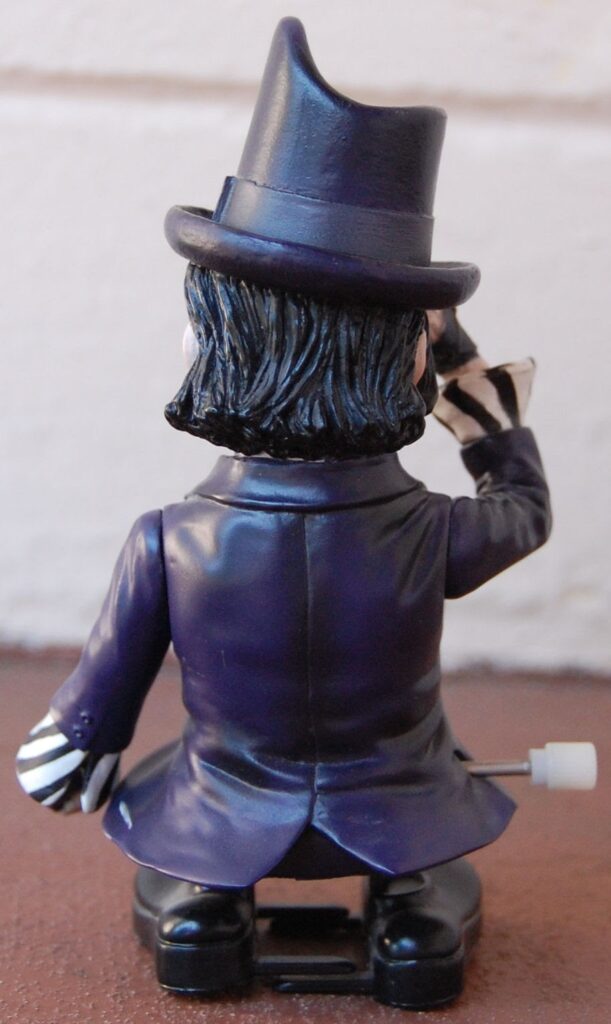
Boyd Rice, one-off-custom-figure by Benjamin Capps aka b9 InViD aka Neofolk Action Figures, 2006
No official or factory made Boyd Rice toys have been released to our knowledge… But we did find this fun one-off custom figure by musician and artist Benjamin Capps aka b9InViD aka Neofolk Action Figures.
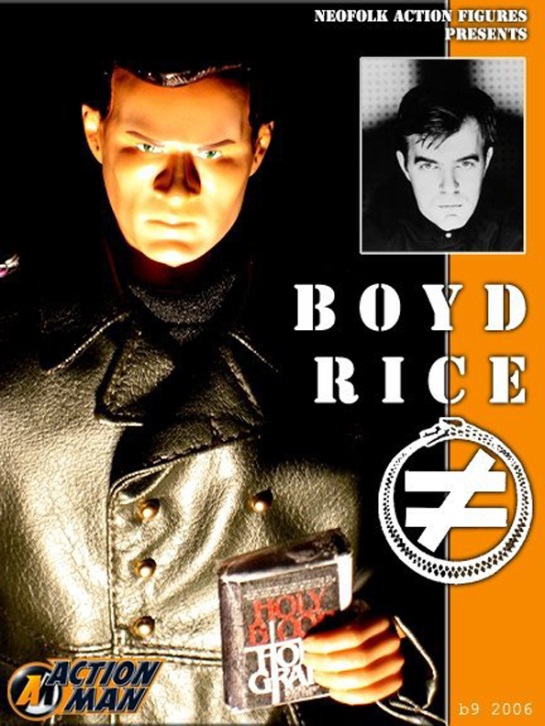
Links
- Boyd Rice interview with Marilyn Manson, circa 1996, from issue 40 of ‘Seconds Magazine’ – Link to read online via Manson Wiki
- Seconds Magazine – Website
- Steven Blush – Website
- Marilyn Manson – Instagram
- Boyd Rice – Instagram
- Boyd Rice – 2019 Interview via The Aither
- Info on Mego’s 1970s Planet of The Apes line – via Mego Museum
- Info on Hasbro’s 1970s Charlie’s Angels line – via Figure Realm
- Info on Mego’s 1970s Farah Fawcett Celebrity Doll line – via Figure Realm
- Info on Mego’s 1970s Starsky & Hutch line – via Mego Museum
- Info on Matchbox’s 1980s Pee-Wee’s Playhouse line – via Figure Realm
- 2 Part Article on Pee-Wee’s Playhouse via The Comics Journal – Link to read Part 1 online
- 2 Part Article on Pee-Wee’s Playhouse via The Comics Journal – Link to read Part 2 online
- Info on Kenner’s Blythe doll – via The Kenner Blythe Guide
- Info on Mego’s 1970s KISS line – via Mego Museum
- Info on Kenner’s 1970s Six Million Dollar Man line – via The Toy Collectors Guide
- Info on Colorforms 1968 Outer Space Men line – via Mel Birnkrant’s website
- Mini Video Documentary about Jay J. Armes and his Action Figure, by That Junkman – via YouTube
- Catalogue Pages for the Jay J. Armes 1970s Ideal Toys – via Plaid Stallions
- Dolly Downs: ‘Introducing Dolly Downs’, article by Leslie Boyd, from White Planes, 2nd December 1992 Issue – Link to read online via Newspapers
- Dolly Downs: ‘Doll Gives Identity to Down Syndrome Children’, article by Melinda Henneberger, from New York Times, 12th December 1992 issue – Link to read online via New York Times
- Info on Fewture’s 2000s Marilyn Manson toy line – via Manson Wiki
- NeoFolk Action Figures – Facebook
Header art by Dan Thrax.
All other images sourced online.
